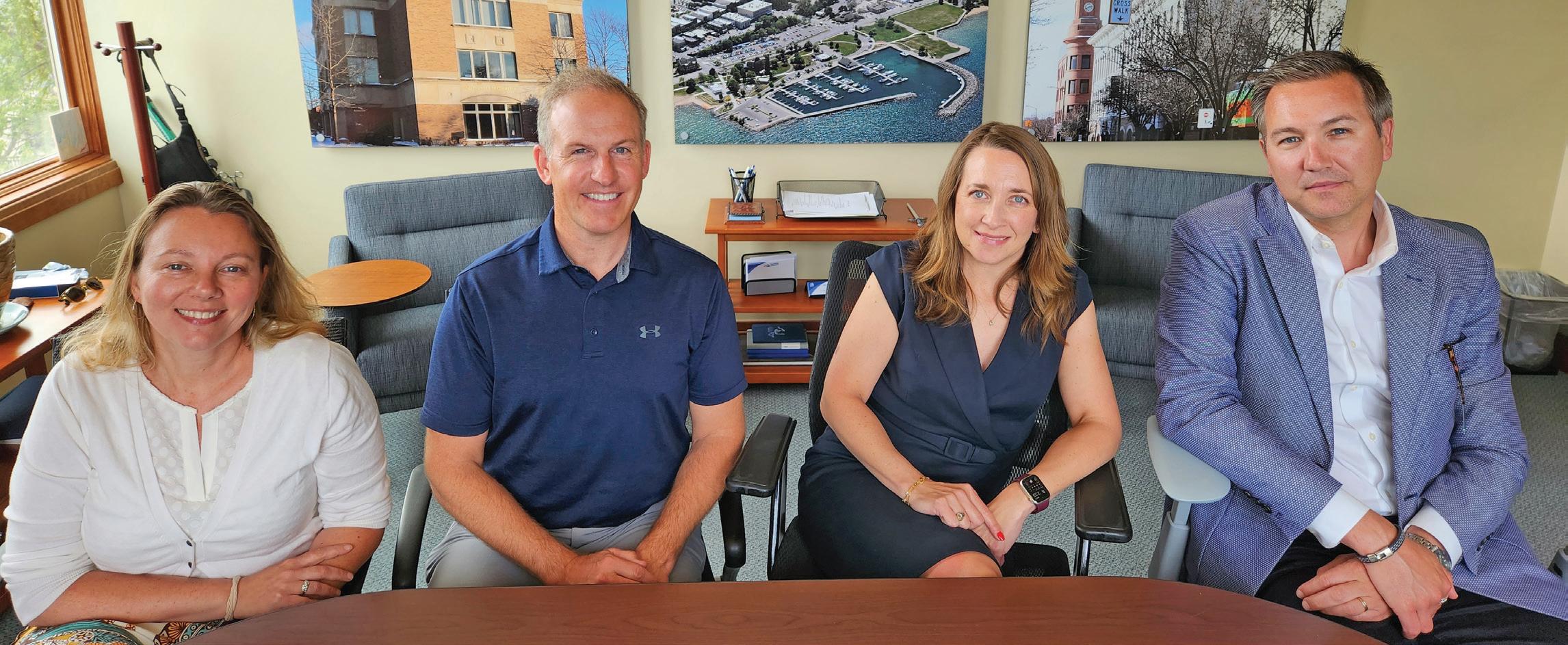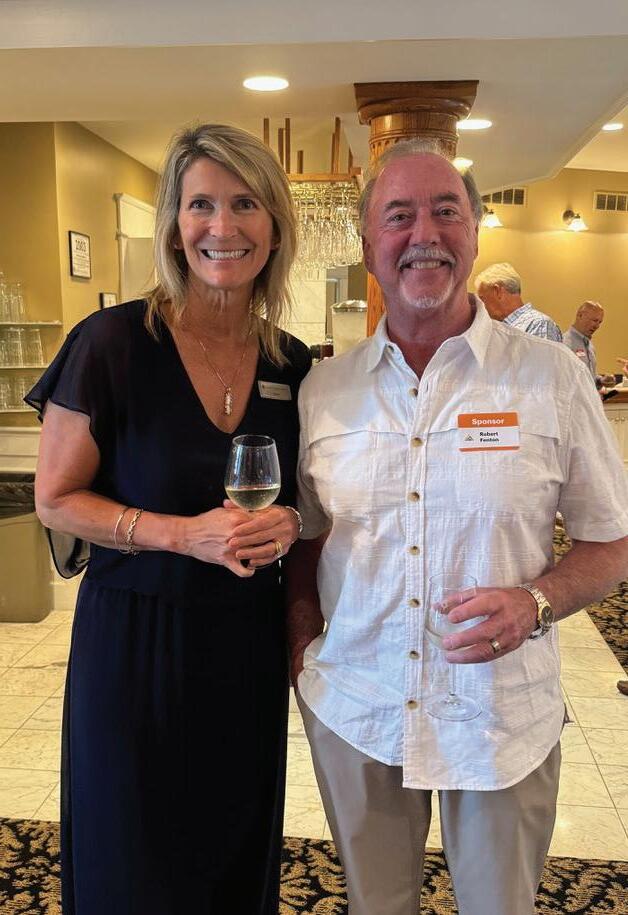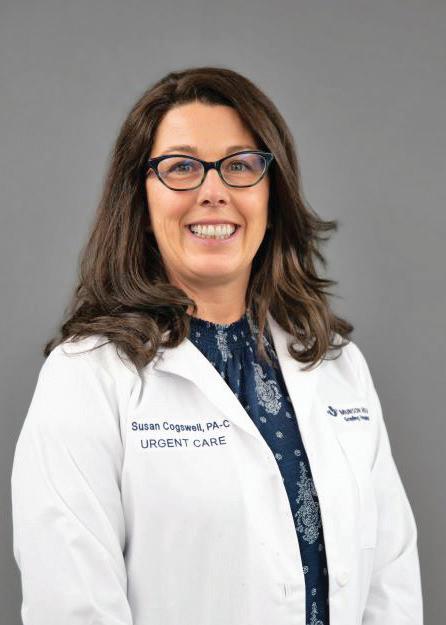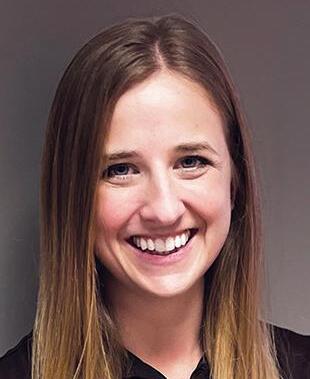
























• We uphold a Fiduciary Standard and work with clients on a fee-only basis.
• We do not receive commissions, kick-backs, or soft dollars from product sales, eliminating inherent conflicts of interest.
• Our team of professionals holds designations and degrees such as CFP®, CFA, CPA, MBA, and PhD.
• Charles received his MBA from the Kellogg School of Management - Northwestern University, his MA in Economics from WMU, and Executive Education from Harvard Business School and Columbia University. Charles Zhang, CFP®, MBA, MSFS, ChFC
• Ranked #1 on Barron’s list of America’s TOP Independent Advisors and is the highest ranked NAPFA-Registered Fee-Only Advisor on the list.*
• Ranked #4 in the nation on Forbes’ list of TOP Wealth Advisors and is the ONLY Independent Advisor in the top 10.**
investment: $1,000,000 in Michigan/$2,000,000 outside of Michigan.
under custody of LPL Financial, TD Ameritrade, and Charles Schwab.

Two Traverse City organizations were recently honored with the 2024 Business/ Organization Humanitarian Effort Award by the City of Traverse City Human Rights Commission for ongoing commitments to helping others in the region. Grand Traverse Industries, celebrating 50 years this year, provides job training, supported employment and day programs to people with intellectual and developmental disabilities as well as services to hearing impaired/deaf clients. J&S Hamburg (South Airport): Project Feed the Kids is a nonprofit founded in 2020 with a mission of fighting food insecurity. It packs more than 3,000 meals a week and makes them available for free to anyone who needs them at stocked coolers in Traverse City, Grawn, Kingsley, Buckley and Kalkaska.
The Great Start Collaborative of Traverse Bay recently selected Cheryl Bloomquist for its Mary Merwin Voice for Children Award. Established in 2005, the Mary Merwin Voice for Children Award is presented to an individual who has provided outstanding leadership, focus and action in the region’s early childhood field. Bloomquist is a longtime member of Northwestern Michigan College faculty in the social sciences department and a leader in a wide range of regional initiatives that have improved and expanded quality early childhood care and education.

Traverse City’s Cultured Kombucha Co., the Midwest’s fastest-growing kombucha company, recently unveiled a brand makeover with a new logo and visual presence. With the new rebrand, the company is embracing its commitment to healthier lifestyle choices while creating meaningful brand engagement with consumers, according to CEO Courtney Lorenz, who founded the company nearly ten years ago. Cultured is sold across the Midwest and continues to expand around the region.
COMPLETE
The Traverse City Golf & Country Club recently completed a $3 million, six-month renovation of its main dining
rooms, including a private dining area, and a transformed lounge and grill. Founded in 1915 and with a current membership of some 560 households, the renovation was undertaken to ensure the rich history of the club continues for years to come.

Great Lakes Environmental Center, Inc. (GLEC) of Traverse City, a longtime client of the Northwest Michigan APEX Accelerator, has received the U.S. Environmental Protection Agency (EPA) Administrator’s Award for Outstanding Accomplishments by a Small Business Contractor. GLEC is an established national contracting firm offering applied environmental sciences, research, and compliance assistance focused on water quality and the protection of aquatic ecosystems. The award recognizes GLEC’s contractor support for implementation of the Unregulated Contaminant Monitoring Rule (UCMR) and development of drinking water standards.
Leelanau County’s newest winery, Three Trees Vineyard, held its grand opening last month. Located at 5200 Elm Valley Road, the winery is owned by Lyle and Phil Cifuentes and business partners Scott and Laurie Muschong. The Three Trees Vineyard team closed on the Suttons Bay property in early 2021 and planted grapevines. Its offerings currently include Cab Franc, Merlot and Pinot Gris. Also in Leelanau County, the Happy Girl Wine Co. recently opened at 405 N. St. Joseph Street in downtown Suttons Bay. The wine shop is owned by Ed and Teresa Bosse. Finally, one of the longest-running motels in the county - the Duneswood Resort - has been renovated, rebranded and reopened as the Dune Climb Inn under new owners Kevin and Michelle Aucello. The establishment is located on M-109 in the heart of the Sleeping Bear Dunes National Lakeshore.



We form strong relationships with our clients –keeping their best interests in mind.
BASEBALL TEAM LAUNCHES FOUNDATION
The Traverse City Pit Spitters have established the Pit Spitters Community Foundation, a nonprofit extension of




KEEN has had the pleasure of implementing energy efficiency and renewable energy solutions throughout Oryana’s two locations.
Oryana West: Solar Panel Installation –83k Wh Solar PV Oryana East & West: New LED lighting throughout
YEARLY KILOWATT HOURS AVOIDED:
228,783 Combined energy for both systems
SAVINGS EQUIVALENT TO: 20+ homes energy usage 147 acres of trees preserved


We chose to work with KEEN for our solar project because of our long-standing relationship. This was a natural extension of our existing relationship and they always manage to understand exactly what we’re looking for.
Sarah Christensen, CEO Oryana Community CO-OP

the Pit Spitters organization dedicated to supporting and enhancing local philanthropic initiatives in the region, specifically those that impact kids and their families. “We are excited to launch the Pit Spitters Community Foundation as a means to further our mission of enriching the lives of those in our community,” said Jacqueline Holm, general manager of the Pit Spitters organization. “Through this foundation, we aim to address key issues in our industry, support vital community programs, and empower local organizations to thrive!”

5Loaves2Fish, a Leland-based nonprofit organization dedicated to alleviating hunger and supporting individuals experiencing homelessness and food insecurity, has appointed new co-directors: Caleb and Corrie Piersma. This leadership change marks the beginning of a new chapter for the organization founded by Bill and Michelle White in 2019. The Piersmas bring a background in nonprofit management, community engagement, and innovative program development. The Whites will continue as 5Loaves2Fish board members and volunteers. Current operations director Emily Kanitz will transition out of her role over the next few months and stay involved as a volunteer.
Steve’s Smokin’ BBQ – a staple since 2001 of events like the National Cherry Festival and Northwestern Michigan Fair – is targeting a July 15 opening for a new brick-and-mortar location in the former Eastfield Party Store space at 831 South Garfield Avenue. Fatherand-son duo Steve and Logan Randell are also launching a sister restaurant at the same location called Firebird Pizza. The two fast-casual eateries will have separate ordering areas but a common dining room. The space has undergone extensive renovations to make it restaurant-ready since the Randells acquired the property in 2019.
According to The Ticker, Steve’s Smokin’ BBQ will feature many favorites from the truck – including pulled pork, beef brisket, ribs with a St. Louis-style dry rub, chicken, and once-a-week turkey legs – plus some new features like smoked sausage. Firebird Pizza will feature 10-11inch Neapolitan-style pies made to order
in a brick oven, with customers able to customize their toppings as well as optional “drizzle finishers,” according to Logan Randell. Planned hours are Monday-Saturday (closed Sunday) 11am-9pm.
A new dog bar has opened in Chums Corner at 4277 Village Park Drive. Joy and Dan Goodchild are the owners of K&A Hop Dogs (named for their own dogs Koda and Abbey), a year-round social environment for dogs and their owners. The property has a designated off-leash area for dogs, an expansive outdoor area, and an indoor pub featuring craft beer, wine, cider, specialty spirits, and NA options. “Like many others, we’ve been to a wide range of dog parks but we just wanted more for our dogs –we especially wanted them to be safe,” Joy Goodchild said. Dogs are required to be vaccinated and socialized in order to be admitted. K&A Hop Dogs is open Monday-Thursday 2pm-10pm and Friday-Saturday 12pm-11pm (closed Sunday), with plans for special offerings like a July Paint-and-Sip event and a Rescue Ale on tap that supports Michigan res cues. A variety of dog memberships are available; humans enter for free except during ticketed events.

The Michigan Association of Airport Executives (MAAE) recently recognized Cherry Capital Airport’s ing Officer Dan Sal with its President’s Award. The award is presented to an airport executive who demonstrates outstanding service to Michigan airports and is a leader within the Michigan Association of Airport Executives. “Dan is a key asset to Team TVC,” said North west Regional Airport Authority Chair Steve Plamondon. “The Northwest Regional Airport Authority agrees with MAAE that Dan is a leader amongst his peers. We appreciate Dan’s leadership and service as an airport professional for the Michigan airport industry.”



STRAWBERRIES
GRANDMA BIRDIES HOMEMADE PIES SOFT SERVE ICE CREAM
CHERRY PIE PARFAITS FLOWERS




VINTAGE FINDS
UNIQUE GIFTS
HOME DECOR
KIDS PLAY MINI COW & GOATS




YOUR FACE DESERVES THE SCAN to schedule a consultation:

















Recently when ringing up my purchase, Amy Reynolds, an owner of Horizon Books, said something that touched my heart.
I had shared with her that I appreciated her service, her “book smarts” and that Horizon Books has prevailed for over 60 years when national chains like Borders had come and gone.
As she was verifying my membership, she made the connection that Althea Petritz was my mom (now deceased) and said that she had enjoyed my mom’s frequent shops there.
It was a simple but powerful example of why Horizon Books has “staying power,” and why it continues to be one of the jewels that keeps downtown Traverse City vibrant and authentic. It also reminded me about the power of community.
In “The Third Pillar: How Markets and the State Leave the Community Behind,” Raghuram Rajan elaborates on the crucial role that communities play in maintaining societal balance and individual well-being. A strong community ensures that the benefits of economic and state activities are distributed more equitably and sustainably, leading to a healthier and more balanced society. An imbalance, when markets and the state overshadow the community, can lead to social discontent and economic instability.
The role and power of community in our region is an underpinning of the quality of life we cherish and reflects a legacy of leadership dedicated to maintaining this balance.
This year’s recipient of the Distinguished Service Award, Gil Bogley, is a great example. In the early 1960s he helped frame the mission of the Traverse
EDITORIAL & BUSINESS OFFICE
P.O. Box 4020
Traverse City, MI 49685
231-947-8787
ON THE WEB
tcbusinessnews.com
PUBLISHER
Luke W. Haase
lhaase@tcbusinessnews.com
CONTRIBUTING EDITOR
Gayle Neu
gneu@tcbusinessnews.com
HEAD WRITER
Craig Manning
COPY EDITOR
Becky Kalajian
City Area Chamber to include “the preservation and enhancement of our natural resources as the cornerstone of our successful economy.” This led to the Chamber becoming a regional collaborator that with its four bordering counties, all committed to stewardship of our natural environment.
Another visionary who helped incubate organizations that support the third pillar is Rob Collier, executive director of Rotary Charities from 1985-1995. He credits the Traverse City Rotary Club for conducting listening sessions in our region that overwhelmingly affirmed a love of land and natural resources. The outcome was the Grand Traverse Regional Land Conservancy.
With Rob’s leadership, Rotary Charities applied this approach to creating the Grand Traverse Regional Community Foundation (GTRCF). Today GTRCF guides investment of approximately $3.5 million dollars annually in direct grants, as well as collaborating with a network of public and private partners to leverage investments to support a thriving and equitable regional community. In Rob’s words, “This spirit of cooperation and collaboration demonstrated in part by these two permanent nonprofit organizations will continue to provide lasting benefits throughout our region. “
There are so many organizations, programs and events in our region that build and sustain a healthy community. One of my favorites is Shop Your Community Day sponsored by the Downtown Development Association, when downtown Traverse City retailers (including Horizon Books) donate 15% of their sales that day to a list of 40 area non-profits that shoppers designate. Last November
CREATIVE DIRECTOR
Kyra Cross Poehlman
CONTRIBUTING WRITERS
Ross Boissoneau
Art Bukowski
Kierstin Gunsberg
Rick Haglund
WEB PRODUCTION: Byte Productions
MAILING/FULFILLMENT
Village Press
DISTRIBUTION
Gerald Morris
SERVING:
Grand Traverse, Kalkaska, Leelanau and Benzie counties
it raised $20,000 for local nonprofits that former DDA Executive Jean Derenzy said “underscores the impact of small businesses and independent retailers in their communities.”
As owners and developers of Crystal Mountain in Thompsonville, our family has had the opportunity and privilege, in a small way, to build community. When Jim and I joined the business in 1985, we thought that our mission was to develop and operate a year-round resort. Fifteen years later, we realized that not only were we developing a magical place for people to visit and play, but also, for some, a place to call home.
Today, in addition to approximately 400 vacation residences, 70 families live here year around in neighborhoods that blend in with the Up North setting. But this community is more than sites, structures, and luscious landscaping. This community seems to share a common quality: Not only do they seek healthy, active lifestyles, but they also want to give back to the greater community. Their contributions range from supporting local school systems, to nurturing gardens in Thompsonville, providing well-paying jobs, and serving in units of local government.
Crystal residents Phil and Cindy Cook created Mrs. Mullen’s Closet of Benzie County, a partnership that provides a “closet” at each elementary school for school staff to quietly help kids and their families when they need it most. Kim and Chris Pickell established the Crystal Scholarship Foundation that awards scholarships to Crystal employees or dependents to pursue a post-secondary education.
Another example of a partnership that builds community is Michigan Legacy
COVER PHOTO: Meg Warzywak-Bowen
AD SALES
Caroline Bloemer
cbloemer@tcbusinessnews.com
Lisa Gillespie lisa@northernexpress.com
Abby Walton Porter aporter@northernexpress.com
Kaitlyn Nance knance@northernexpress.com
Todd Norris tnorris@tcbusinessnews.com
Michele Young myoung@tcbusinessnews.com
Art Park. Thirty years ago, local artist and architect Bob Holdeman brought to us the concept of locating Art Park at Crystal on 30 acres of steeply sloped and forested land within our 1500-acre campus. Today the Park welcomes over 18,000 visitors annually to discover 50+ sculptures on a 6km hiking trail; to experience concerts at the amphitheater, and to celebrate art that students have created there.
Marsha Smith, executive director of Rotary Charities for 24 years and recipient of many awards including Lifetime Humanitarian by the State of Michigan, described the impact of community eloquently.
“I have been thinking about community-building since I visited Taliesin West, built around Wright’s principles of architecture, space, site, materials, and democracy. It’s the last design principle that is the most important: democracy – about places that work for everyone,” she said. “Yet, it is more than that. True communities are based on honest connections, mutual respect, acceptance and tolerance of differences and a commitment to good old-fashioned common courtesy. These are the things that we can all bring to truly build our communities.”
Thank you Marsha, Amy and so many others in our region, past and present, for your dedication to building true community – one that sustains a healthy, well-balanced society now and in the future.
Chris MacInnes is president of Crystal Mountain. In 1985, she and her husband Jim moved from California to join this business and together have led its evolution. She is also active in state, local and industry organizations.
The Traverse City Business News Published monthly by Eyes Only Media, LLC P.O. Box 4020 Traverse City, MI 49685 231-947-8787
Periodical postage qualification pending at Traverse City, MI.
POSTMASTER: Send address changes to The Traverse City Business News, PO Box 1810, Traverse City, MI 49685-1810.
The Traverse City Business News is not responsible for unsolicited contributions.
Content ©2024 Eyes Only Media, LLC. All rights reserved.
EYES ONLY MEDIA, LLC









By Art Bukowski
Nick Jacqmain is CEO and president of Kingsley-based Springfield Commercial Roofing and Transport. Founded in 1985, the company is a nationally recognized, locally trusted source of commercial roofing, building maintenance/repairs and transport services. We thank Nick for showing us around his workspace! If you have an idea for a From The Desk Of feature, please email Art Bukowski at abukowski@tcbusinessnews.com


1. Our team continues to be recognized for their quality craftmanship in commercial roofing. This year, we received the inaugural Duro-Last Michigan Platinum Contractors Award, which recognizes Springfield for its high inspection scores.
2. I’m a big notetaker. I recently invested in an iPad to better organize my notes versus getting frustrated flipping through my old school notebook. It’s been a gamechanger in the office and on the road.
3. Delivering printed proposals to customers in a faceto-face meeting is an important component of our sales process. Almost every team member touches the proposal before delivery.
4. My sister gifted me this business card holder when I graduated from college (fire up, Chips!). It sits front and center of my desk and has followed me through my career journey.
5. Each August we attend the Northwest Michigan Fair and purchase livestock from a local 4-H member. We then take it to be butchered and disperse it amongst the team.
6. I can’t live without a bag of peppermint Lifesavers in the office. I don’t chew gum because I worry I’ll forget to toss it before a meeting. Plus, the peppermint helps settle my stomach on those days I might have eaten something I shouldn’t have at lunch.
7. We received this mini billboard from Lamar after running a campaign. It was one of the biggest marketing risks we took at the time, but we received a lot of great feedback and recognition from that campaign.
8. One of my favorite things in my office is this custom neon clock. It was a Christmas gift from the Springfield team – and they nailed it!
Photo by Meg Warzywak-Bowen

By Art Bukowski
Troy Daily doesn’t have a lot of speeds. The default is fast, but he can shift to “faster” if the situation merits. His mind is always running, his legs are always moving, his phone is always ringing. There just aren’t a lot of other options when you have so many irons in the fire.
Traverse City’s serial entrepreneur is responsible for a long list of businesses and activities over the past decade, mostly in the tourism, recreation and hospitality arenas. He’s lost count of the LLCs he has (it’s over 20) or the initiatives he’s launched by himself or with others, but on the list are longtime brands like Kayak, Bike & Brew, TC Cycle Pub and Brew Bus along with newer entries like the Daily Blend food truck, Seven Hills and Old Mission Distilling.
All of this while working as a licensed Realtor and a licensed builder, running a property management company and raising three young girls.
When asked about all of this – how it’s possible to handle it all without imploding in on himself like some sort of neutron star – Daily repeatedly credits his wife, Whitney, and his 80-some employees spread across his various businesses. Ideas are fun, he says, but it’s the people around him that truly make the magic happen.
“I just have to give kudos to the whole team. It’s all about my people,” Daily said. “I can’t do what I do without my team, and my trust in my people is the biggest reason for success.”
Daily, 38, is a Traverse City native. His parents, Mary and Brian Daily, owned and ran the Kilwins on Front Street for three decades before retiring last year. It was in that shop that the younger Daily’s appreciation for small business (and his entrepreneurial spirit) were kindled.
“I saw all these things they had to do to run a profitable business, accounting and things like that, but you also had to understand the hospitality side of it and wrap all of that into it as well. At Kilwins, we always said we sold enjoyment,” he said. “And work ethic is huge. Being able to see my parents work every day, open to close…was inspiring.”
After graduating from Michigan State University with a degree in hospitality business, Daily moved to Virginia to open up a Kilwins there. He ran it for about three years in the midst of the late 2000s economic downturn before closing it and moving back home.
He came back to Traverse City with an idea after seeing something similar to what became the cycle pub during his time in Virginia. He launched the Traverse City version in 2013, marking the formal beginnings of an empire that keeps growing every year.
A large degree of Daily’s success has been harnessing the zeitgeist of combining hospitality with recreation, a trend that rose in lockstep with the Grand Traverse region’s massive growth in food and drink options over the past decade.
“These experience-based things just really exploded,” Daily said. “And we were seeing the growth of all of the breweries and other businesses. It just kept spurring me on. What else can we do?”
The businesses and brands keep coming in part because Daily has what you might describe as a mild addiction to the thrill of launching a new one. Always wanting more is a “curse and a blessing,” he says, but he wouldn’t have it any other way.
“I have so many businesses because I love creating them. It’s my favorite part, by far. I love the startup, all the excitement and marketing that goes into it,” he said. “When it comes to executing and operating, I’m really not all that good, so I hire good people to take it on. You have to hire good people to make sure the dream can become a reality.”
But he’s also practical. The vast majority of what he starts has staying power, and that’s because his operations are usually well-researched and based on something he’s determined to be feasible from a business standpoint.
“I really just look for needs in the market,” he said. “The whole kayak experience, for example, was just doing something unique that people wanted to do while visiting these breweries.”
While there might not be competition to something as broad-reaching as the Daily empire, there is certainly increasing competition for some of his individual brands, especially as more experienced-based recreation comes online. This drives Daily to innovate, and the need to do so is almost always on his mind.
“We need to up our game, keep the model fresh. A lot of my businesses are nine, 10, 11 years old, and we can’t just keep doing the exact same thing we’ve always been doing. People want something new,” he said. “How do you stand out? How do you make yourself unique?”
He also has a keen eye for growth. Cycle Pub has gone from one bike to four. Brew Bus went from one bus to 16. Suds and Snow started with 600 people and recently had more than 3,500 people. But he insists to himself and to his staff that growth will never mean a reduction in quality, safety or principles.
“I pride myself in being a local,” he said. “I live here too, and I always want to have a reputation for doing things the right way.”
Many of Daily’s businesses involve alcohol, which is always a sticky wicket when it comes to public perception and municipal approvals. He speaks strongly in defense of his business practices, which he says have a big focus on safety and responsibility.
“Whether you like drinking or not, I’m doing things the right way. We’ve never had an accident. We’ve never had any issues. We’ve never had the cops called on us. And we’ve had hundreds of thousands of people without incident because we’re doing it the right way,” he said.
With many of his brands catering to tourists, Daily is also caught in the crosshairs of intense and increasing ire over tourism’s impact on the city.
“Our city is evolving, and it’s changing constantly. Being able to stay in a positive light in what I’m trying to do to grow sustainable business is very hard. The more we have tourism, the less people want it,” he said. “I don’t have all the answers, but I try to do the best I can (in running my operations).”
Like seemingly everyone else on the local business scene, one of Daily’s biggest issues over the last few years has been hiring. This is especially stressful for a man who relies heavily on good talent to run his operations.
“No one wants to work. That’s the reality of it. And if they do, you have to pay them way more than they’re worth to get what you want out of them, and you might not even get that,” he said. “It’s a huge, huge challenge.”
It’s a busy life, but if you’re counting on Daily slowing down any time soon, don’t hold your breath. The only thing that will cause him to pump the brakes is if his schedule starts to have a negative impact on his wife and kids.
“My wife holds it all together, and it’s not easy, dealing with someone like me who can’t really turn it off,” he said. “But at the end of the day, everything I’m doing I’m doing for my family.”
An incomplete look at some of the business, brands, events or initiatives Daily has launched:
2013 - TC Cycle Pub
2013 - Paddle For Pints
2014 - Kayak, Bike & Brew
2014 - Brew Bus
2014 - Daily Blend
2015 - TC Ale Trail
2015 - Purchased Suds & Snow
2017 - Flapjack & Flannel Festival
2017 - Strongbrew Cold Brew Coffee
2017 - Alley’s Market
2019 - Elevated Property Management (now Elevated Homes & Hospitality)
2019 - Old Mission Holdings (construction)
2020 - Jacob’s Farm revamp
2021 - Obtained real estate license
2023 - Seven Hills and Old Mission Distilling
2024 - Obtained builder’s license

At Nicolet Bank, we believe every great success story starts with a conversation. Look to your local, experienced commercial banking team, who work and live here, and understand our local economy is built on shared success.




Michael Caruso
SVP Commercial Banking
231.941.6303
mcaruso@nicoletbank.com
John Galbraith
VP Commercial Banking
231.632.9331
jgalbraith@nicoletbank.com
Jeremy Harnish
SVP Commercial Banking Manager
231.941.6306
jharnish@nicoletbank.com
Andrew Sabatine
SVP Commercial Banking
231.941.6301
asabatine@nicoletbank.com
People. Real Conversations. Traverse City NicoletBank.com 800.369.0226 Member FDIC

TCNewTech’s grand return underlines 20Fathoms’ long-running commitment to health-tech
By Craig Manning
This spring marked a big return for TCNewTech, the local community pitch competition that works to elevate early-stage, Michigan-based startups. After a six-month hiatus, the contest surged back to life in a new form – and with the spotlight focused on a business sector with a growing presence in northern Michigan: health technology.
Since its inception in 2015, TCNewTech has featured more than 250 different early-stage companies. Every month, the contest would invite startups to the stage of the City Opera House to compete for a $500 cash prize, awarded by audience vote. In its first eight years, TCNewTech awarded approximately $40,000 in pitch prizes, helping to lift up local startups like Hybrid Robotics, FirstIgnite, Stocked and MeetingMaker.
In October of last year, TCNewTech’s future was called into question by the announcement that the organization would be taking an indefinite operational pause. In an email to TCNewTech followers, the TCNewTech board shared that the event series had “come to a point in its development that we need to reflect, regroup, refresh, and redirect the next steps toward
our strategic growth to continue delivering a high quality and recurring pitch event to the Grand Traverse region.” The email concluded with a promise to “come back stronger.”
Another major announcement followed two months later, this one bringing the news that TCNewTech programming
time and resources to ensure that TCNewTech events remained “a not-to-be-missed experience for founders, investors, and startup enthusiasts throughout Michigan.”
Now in its new era, TCNewTech looks a bit different than it once did.
The audience choice award is still worth $500, but 20Fathoms has raised the
“We have the expertise of long-time leaders like Munson Healthcare and Thompson Surgical Instruments, and we’re also seeing this burgeoning energy and new solutions coming from biotech startups like Atterx and MediCool Technologies...”
– Eric Roberts, executive director, 20Fathoms
would be absorbed and “seamlessly integrated” into local tech hub and incubator 20Fathoms – itself fresh off a $7.3 million windfall courtesy of state and federal grants. 20Fathoms pledged to hire a fulltime manager to produce future TCNewTech pitch competitions and other events, and Executive Director Eric Roberts vowed that 20Fathoms would invest the
stakes, adding a panel of expert judges who deliberate on the pitches and pick first and second-place winners – honors worth $5,000 and $2,000, respectively. TCNewTech also now offers pitch coaching sessions and three months of access to the 20Fathoms workspace for pitch finalists, among other benefits.
The new era kicked off on April 23
with a “University Showdown,” which brought startups from universities throughout the state of Michigan to compete on the Opera House stage. That entry on the TCNewTech event calendar was part of Northern Michigan Startup Week, which this year had the theme of “Rural Health Innovation.” To coincide with that theme, TCNewTech specifically courted a crop of university startups that are doing work in the health-tech arena. Health-tech is a foundational piece of 20Fathoms’ history. After launching in 2018, the incubator made health-tech one of its first focus areas, launching a program called HealthSpark in 2019 that sought to attract health-tech companies to northern Michigan, create high-paying jobs within the health-tech space, and build a “culture of health” throughout the region. At the time, 20Fathoms already counted a few health-tech companies among its early success stories – including HealthBridge Financial, a company that works to simplify the gaps between health insurance coverage and out-of-pocket expenses; and Spire Health, which builds remote patient monitoring devices for people with chronic respiratory disease. In 2021, 20Fathoms and HealthSpark hosted a 12-week “HealthSpark Acceler-
ator” program, which sought to harness the brainpower of more than 200 business and healthcare minds to help small businesses bring healthcare solutions to rural areas like northern Michigan. The program graduated 10 health-tech startups, including Nurse Disrupted, a virtual nursing platform since featured on the TODAY Show; and Eebu Health, an automated patient follow-up system which in 2022 won “Best Technology” honors from New Enterprise Forum, a Michigan-based startup support network.
HealthSpark no longer exists, at least not by name, but Roberts is adamant that its mission of establishing northern Michigan as a health-tech hub continues at 20Fathoms – and throughout the local business community.
“The delivery of healthcare is changing rapidly, and this is particularly impacting rural areas of the country like northern Michigan, which have historically faced major challenges related to access to care, doctor shortages and more,” Roberts said. “Technology innovation in healthcare has the potential to level the field and save lives – and Traverse City is in a great position to lead those efforts. We have the expertise of long-time leaders like Munson Healthcare and Thompson Surgical Instruments, and we’re also seeing this burgeoning energy and new solutions coming from biotech startups like Atterx
and MediCool Technologies. Healthcare innovation is a natural fit in Traverse City, and that was reinforced by the interest and engagement in this industry that we saw during Northern Michigan Startup Week and the TCNewTech University Showdown.”
The University Showdown featured five startups, including three out of the University of Michigan, one from Michigan State University, and one from Central Michigan University. U of M’s Intero Biosystems and its founders, Charlie Childs and Madeline Eiken, took home both the $5,000 grand prize and the $500 audience choice award.
Intero Biosystems is a biotech company that specializes “in the creation of organoid platforms for drug discovery and development.” The product is a first-ofits-kind “stem-cell derived Human Intestinal Organoid,” which contains “many functional cell and tissue types found in the native intestine” and is therefore capable of “mimicking the human intestine ‘in a dish.’”
Taking home the $2,000 second-place prize was another woman-led U of M startup, called MinaRosa, which “offers a portable and private light-therapy solution for urinary tract infections as a medication alternative to empower all people, especially women for whom antibiotics are ineffective, to take back control of their


well-being.”
Other pitch finalists included U of M’s Dialysis Innovations, MSU’s Reel Free, and CMU’s Vitamin Clinic.
Dialysis Innovations pitched CORE (COnnecting REsearch), a software platform that seeks to “democratize clinical trials” by using machine learning technology to match “participants with the clinical trial sponsor.” Reel Free is a medical device company “dedicated to
revolutionizing oxygen therapy management for seniors and individuals with oxygen deficiencies.” Finally, Vitamin Clinic works at the nexus of the nutrition and video gaming industry, by providing “customized freshly prepared smoothies and meal plans to clients based on their health status, preferences, and dietary needs while transforming their somewhat challenging journey for healthy living into an exciting quest through games.”


• Beautifully wooded 5-acre estate size lots with rolling hills
• Surrounded by thousands of acres of State Land!
• Maintained paved private road with electric, high-speed internet
• RV camping and storage building is permitted!

• Direct access to recreation trails, just minutes to Elk Lake or Guernsey Lake
• Easy commute to Traverse City
• Short drive to Tur tle Creek Casino, Grand Traverse Golf Resort, and Meijer store in Acme
Starting at $174,900

By Craig Manning
The better part of a decade ago, Greg Tarrell says he saw an “inflection point” in the world of technology, and used it as motivation to start his own business, LooUQ (pronounced “look”).
Today, LooUQ is a growing enterprise with clients all over the country – including a Fortune 500 company. Not bad for a venture that started, in Tarrell’s words, as “a leap of faith.”
LooUQ is in the business of connecting devices to one another, “anywhere, anytime.” Using proprietary cellular modems and smart sensors, the company helps
businesses in a broad array of industries network their devices as part of the so-called “Internet of Things” (IoT). The goal, Tarrell says, is to help businesses achieve new levels of operational efficiency through seamless communications, data collection and more.
Therein lies the “inflection point” Tarrell says he foresaw almost 10 years ago.
“I saw that technology was starting to change, specifically with miniaturization,” he says. “We were starting to hear that catchy phrase – the ‘Internet of Things’ – everywhere. And the idea was that, sooner or later, there were going to be a lot of devices on the internet that weren’t just a person sitting in front of a keyboard. They were going to be other types of devices, and they would change the way we do business. So, it was a very broad topic that I was trying to capitalize on, and I figured that if I could get in early enough and be an expert on how to (connect devices to the IoT), there would be a demand for that.”
Though the IoT trend was in a relatively fledgling state when Tarrell started LooUQ in August 2015, his professional background meant he was well-positioned to pivot toward this growing avenue of innovation. Tarrell paid his way through college at Michigan State University by working as a data communications operator for a large Midwestern bank, back when this kind of equipment was big enough to fill buildings.
“So, ever since college, I’ve worked in information technology – almost always in some capacity of data communications, of getting data from one point to another,” Tarrell says. “Over my career, I slowly moved up the ranks and became a manager and a director. One day, I realized that I’d pretty much achieved everything I wanted, but looking back, I
also realized I’d had the most fun when I worked for a smaller company and I got to play with the electronics.”
Tarrell’s desire to take his career back to basics – along with the idea of getting into the IoT space – led to the inception of LooUQ. He started the company in East Lansing, with support from one of MSU’s incubators. Then in 2019, Tar-
Michigan. That helped me realize that it didn’t matter if LooUQ had an East Lansing zip code or a Traverse City zip code. And if it didn’t matter, I’d rather move home – because I’ve always considered northern Michigan home.”
From its hub in northern Michigan, LooUQ makes LTE data communications devices, offers IoT-specific data

“That helped me realize that it didn’t matter if LooUQ had an East Lansing zip code or a Traverse City zip code. And if it didn’t matter, I’d rather move home – because I’ve always considered northern Michigan home.”
– Greg Tarrell, owner, LooUQ
rell says he felt the pull of his hometown – he grew up in Cadillac – and decided to move LooUQ north. The company now does business out of Traverse City.
While Tarrell has involved himself in the local business community (he’s affiliated with 20Fathoms and various regional networking and business groups), and while LooUQ does have a TC-based customer, most of the company’s dealings are outside of northern Michigan.
“I have one local client that I do consulting and software development work for, but all my other customers aren’t local,” Tarrell shared. “As a matter of fact, when I moved up here, none of my clients were even in the state of

plans and cloud infrastructure for device management, and provides product engineering services to help companies “realize (their) IoT vision.” According to Tarrell, it’s work that can take on a lot of different forms, depending on the needs of the specific client.
“One of our customers, their product is a portable solar farm,” Tarrell said. “It’s essentially a solar array mounted on a trailer, and they’ve designed their own electronics controller to run the array, and then they use the LooUQ modem to communicate data back to the enterprise. So, at all times, they know how the solar panels are performing, how batteries are performing, and so on.”
Tarrell also notes that the constant forward momentum of the technology world – including improvements in miniaturization and low-power operations – are driving new possibilities for the IoT every day. Recently, he’s been working on a new sensor for portable restroom companies to utilize in their portable toilets.
“It basically watches the tank using a type of laser sensor, to determine if the portable toilet needs to be emptied,” Tarrell explained. “And that capability really only showed up in the last five years: a very low-power device that’s small enough that you can’t see it. Most people would probably think of a portable toilet as being as stupid as it gets, but with this sensor, we’ve found a way to reduce service calls when they’re not required. The operator doesn’t need to send a truck to go empty the tank unless it needs emptying. And the great thing is you can take that kind of concept and apply it to all kinds of different things around the question, ‘Does it need service?’ It could be a tank that needs emptying; it could be a shelf that needs to be restocked; it could be anything.”
All that possibility equates to growth potential for LooUQ, and while Tarrell is the company’s only employee at the moment, he hopes to take things to the next level soon.
“Particularly with our Fortune 500 customer. I started working with them directly about a year ago,” Tarrell said. “I’d like to see our business with them grow. I’ve got a couple prospects for an ongoing product family with them, so it’s just a matter of making sure that the business is firm and well-funded. But, with that growth in mind, we will hopefully be adding an engineer to our team this year.”
When it comes to serving clients, Melissa is a straight shooter. She works closely with them to make sure their transactions are a complete success. If you’re buying or selling a home or property, ask for Access. We’re the local title experts.


By Lindsay Raymond, columnist
Employers are generally familiar with the Equal Employment Opportunity Commission (EEOC) and the Department of Labor (DOL), federal agencies that enforce numerous laws related to employment. However, these agencies are only a few of the total that regulate and impact the workplace. The bowl of employment law alphabet soup is quite large, and employers must dig in to ensure they are ready for compliance.
One acronym and agency that may not be as familiar to non-unionized workplaces is the National Labor Relations Board (NLRB). Over the past few years, the NLRB has taken numerous actions that greatly impact the way employers can regulate and address employee conduct. Unbeknownst to many employers, these decisions apply to most private sector workplaces, regardless of whether they are unionized. After the NLRB recovered nearly $54 million in back pay and reinstated more than 6,300 workers in fiscal year 2021 alone, employers can no longer afford to ignore or be uninformed regarding the NLRB or the National Labor Relations Act (NLRA).
What are the NLRA and NLRB?
The NLRA is a federal law that protects the right of nonmanagerial, nonsupervisory employees to organize, bargain collectively with their employers, and engage in other protected concerted activity, with or without a union (known as Section 7 rights). Section 7 rights include, without limitation, the right to discuss wages and benefits and other terms and conditions of employment, and take action with one or more co-workers to improve working conditions. The NLRA prohibits discrimination and retaliation for engaging in or refraning from these protected concerted activities. The NLRA applies to almost all private sector employers.
The NLRB is the federal agency that enforces the NLRA. The NLRB has 26 regional offices and is headquartered in Washington, D.C. The offices investigate and prosecute alleged violations of the NLRA under the authority of the General

Counsel. The NLRB receives approximately 20,000 to 30,000 charges per year from employees, union and employers alleging unfair labor practices. The NLRB has the authority to order back pay, reinstatement, and other damages directly resulting from loss of employment.
The board generally has five members and primarily acts as a quasi-judicial body in deciding cases in administrative proceedings. The NLRB is technically an independent agency, but board members and the general counsel are appointed by the president of the Unites States, and board decisions are often made on party lines, at least recently. Further, several decisions seem to be revisited and overturned when the administration changes, bouncing between employer and employee interests.
Recently, the pendulum appears to have swung strongly to the employee-side of the scale and now many employer work rules that were previously upheld as lawful
have been struck down as overbroad, ruled to impermissibly infringe or chill Section 7 rights.
The NLRB’s “Stericycle” decision in fall of 2023 (372 NLRB No. 113) overturned a more employer-friendly, Trump-era standard for evaluating whether facially neutral employer policies and work rules infringed on employees’ Section 7 rights. Prior to this decision, the board was following the “Boeing” standard (365 NLRB No. 154 (2017)), which viewed employer work rules through the lens of an “objectively reasonable employee” and balanced the nature and extent of the potential impact on Section 7 rights versus the employer’s legitimate justifications for the work rule. In practice, this gave substantial weight to the employer’s justification for having a particular rule.
For instance, if the employer had a rule that said “Employees must be professional at all times,” under the old standard, the NLRB would ask whether an objectively reasonable employee would interpret that rule to chill their rights to engage in protected Section 7 activities, and it would also consider the employer’s legitimate justification for the rule of trying to maintain professionalism and order in the workplace. Under that older standard, that work rule would have likely been upheld.
However, under the new “Stericycle” standard, the work rule is viewed through the different lens of the “economically dependent employee” who, by nature of that financial dependence and power imbalance, would be more inclined to interpret an ambiguous rule to prohibit or chill their right to speak up about and/or take action to change their terms and conditions of employment. If the rule can be “reasonably” interpreted to chill Section 7
rights through that lens, then it is now presumed unlawful. That presumption can only be overcome by a “legitimate and substantial business interest that could not otherwise be protected by a more narrowly tailored rule.” Thus, a legitimate business interest is no longer sufficient – the employer must show not only that its interest in the rule is legitimate, but also that the rule is as narrowly tailored as possible to ensure it is clear to the employee and manager implementing the policy that it will not be applied in a manner that chills or violates Section 7 rights.
Under this new standard, a rule stating that “Employees must be professional at all times,” is overbroad and unlawful – it could be interpreted to apply to protected activity like collectively speaking up to a supervisor about terms and conditions if that was considered to be “unprofessional.”
Likewise, the NLRB has recently found the following policies to be overbroad:
• Expecting employees to be positive or to maintain a positive work environment;
• Prohibiting disrespect toward supervisors;
• Prohibiting false, profane, or malicious statements toward or concerning the employer or other employees;
Employers should work with their legal counsel to assess their policies and work rules for NLRA compliance. Some
Under this new standard ... almost every handbook I have seen has at least one policy that would violate the NLRA. Thus, the unfair labor practice charges may now be ripe for the picking.
• Broad non-disparagement policies; Prohibiting conduct that may harm the business’s reputation; And more.
Under this new standard, based on my experience, almost every handbook I have seen has at least one policy that would violate the NLRA. Thus, the unfair labor practice charges may now be ripe for the picking.
policies or rules may be in place simply because they were created 30 years ago and the employer never changed or revisited them (like a policy stating “Employees cannot discuss their compensation,” which is definitely problematic). An assessment now will give employers the chance to consider whether the rules on the books are actually utilized in practice and if they are currently
serving the employers’ needs. By viewing the policies through this revised lens, employers can be more intentional about their wording and narrowly tailor their policies and rules to address their specific concerns.
Although the NLRB has indicated that a general disclaimer in a handbook about Section 7 rights is not dispositive of this issue, placing a disclaimer in your handbook and particular policies that may impact Section 7 rights can help to put your employees and managers on notice that the policies are not intended to and will not be enforced in any way that unlawfully violates the NLRA.
Finally, employers need to become comfortable with discomfort. Once their policies and work rules are updated, they will need to be regularly reviewed and refined. Every four years the administration in power may change, and with it, so may the composition of the NLRB board members. Thus, the pendulum may swing the other way, and “What once was old, will be new again!”
Lindsay Raymond of DAR Law is a business owner and an experienced employment law attorney who counsels employers on workplace compliance. You can reach her at lraymond@ darlawyers.com.












By Josh Traeger, columnist
On the first sunny Saturday in June, my son decided to set up a lemonade stand on our street corner. Wanting to kickstart his entrepreneurial journey, I gave him twenty bucks, a ride to Oryana to buy supplies, and a stash of cardboard boxes from a recent delivery.
I figured he would eventually repay me from his earnings, but I’m not one to require our father-son deals to be in writing. If I did that, I’d be knee deep in “you can do that if you clean your room first” contracts, the legality of which are still in question.
With a fresh supply of lemons and sugar, and beautiful hand-painted cardboard signs advertising his storefront, my son ventured into the cutthroat world of small business ownership. Four hours later, he returned home, out of inventory but flush with cash. $143 to be exact.
Of course, I then asked for my original $20 back. And in that moment, I encountered the stark reality of informal business arrangements – my son’s utterly confused look as I asked for the money, coupled with my own guilt and confusion at our lack of mutual understanding. Wasn’t I clear with him this was a loan, not a gift? Didn’t I explain to him I would want my initial investment returned? And why in the world didn’t I charge him interest?
For northern Michigan business owners, this story is a microcosm of the entrepreneurial realities that arise with informal agreements. Maybe you borrowed money from an uncle to get started, or you have a handshake understanding with a neighbor to utilize your services, or you rely on a family friend to help with a project “free of charge.”
These arrangements often stem from trust and goodwill, but as a seasoned small business attorney, I’ve seen firsthand how quickly they can cause confusion, disagreement, and dissension.
So let’s shore up your informal business dealings with a few simple steps:
Communicate Clearly
The biggest problem with informal agreements occurs when the two parties have different visions. You must create situational clarity and understanding by

having a detailed conversation about expectations, responsibilities, and timelines.
First, define the scope of your agreement. What exactly are you expecting from the other party, and what will you be providing in return? For example, if your friend is offering marketing services in exchange for equity, outline what specific marketing tasks they will handle and how those tasks will be completed. Likewise, if you are offering services to a neighbor as a test case for the viability of your business, define what you will specifically deliver and what you expect in return. The more detailed you are in these expectation-setting conversations, the better.
Next, discuss deadlines. When is the work expected to start, and by when should it be completed? Establishing clear timelines to include a schedule for updates or progress reports helps prevent misunderstandings and ensures both parties know what to expect and when.
Finally, be sure to document your expectation-setting conversations. Taking notes is immensely helpful when you’re faced with disagreements in the future or if you eventually work toward drafting a formal agreement. A common method of documentation is a follow-up email, outlining what was originally discussed. Although this type of documentation may not hold up in a court of law, it operates to keep all parties on the same page, ensuring you both have a record of what was discussed and agreed-upon, to be referenced in the event of any discrepancies.
There are good reasons you may ask a friend or family member to be involved in your business’s early stages – you trust they have your best interests in mind.
business savvy
And, for them, their love and support of you will motivate their participation. But when businesses break down or fail, the trust and love of personal relationships often cause emotional reactions that are hard to control.
How can we do our best to separate business and personal? The simplest way is to put things in writing. Draft and sign a contract outlining the parties involved, terms and conditions, compensation details, need for confidentiality, means of termination, and how disputes will be resolved.
In the early stages of your business, it may make financial sense to draft these contracts on your own. But as your entrepreneurial arrangements increase in complexity and cost, consult a small business attorney to review your agreements and align them with legally-sound best practices.
When you’re just getting started, you may not have the time, proof of concept, or know-how to formalize every possible arrangement. Sometimes, you just need to get moving and leave the details for later. But there comes a tipping point in any small business when the nimble, flexible benefits of informal agreements are outweighed by the uncertainty they cause and the danger they present.
What is that tipping point? Like any lawyer loves to say, “it depends.” But, to me, two factors are key to that calculus:
1. The degree to which you can successfully manage the relationships. Perhaps most importantly, a small business owner’s ability to handle the personal side of informal agreements is key. When you begin to be overwhelmed by the lack
of structure and clarity, it’s time to think about documenting and standardizing your informal agreements.
2. The amount of your business that remains “informal.” When you’re just starting out, your best customers and biggest supporters may be friends and family. But over time, your market will grow. When your friends and family begin to monopolize your time, despite being a shrinking percentage of your market, that’s when you know that those informal agreements must be phased out.
It took a moment for my son to come to terms with my request. He reluctantly returned my invested $20, but then smiled as he wrote down the few items he wanted to purchase with his profits. Our informal arrangement had worked out – my investment returned, his business successful, our relationship intact. But we had our community to thank for that success! If many of you hadn’t purchased watered-down lemonade on a random Saturday afternoon, my son could have learned a business lesson the hard way.
As his lawyer, and his father, I’m here to protect him from – and counsel him through – life’s hard lessons, including those of a budding entrepreneur. I’m also here to love him. So, that night when he fell asleep, I quietly snuck into his room and put the $20 back in his piggy bank. After all, business is personal.
Josh Traeger is the founding attorney of True North Legal Group, a community-centered law practice based in Traverse City. He can be reached at (231) 800-8654 or josh@truenorthlegalgroup.com. Learn more about True North Legal Group at www.truenorthlegalgroup.com


Atlanta- ATL
Boston- BOS
Charlotte- CLT
Chicago- ORD
Dallas/Fort Worth- DFW
Denver- DEN
Detroit- DTW
Fort Lauderdale- FLL
Houston- IAH
Minneapolis- MSP
Newark- EWR
New Haven- HVN
New York-LaGuardia- LGA
Orlando/Sanford- SFB
Philadelphia- PHL
Phoenix/Mesa- AZA
Punta Gorda- PGD
Tampa/St. Pete- PIE
Washington DC-Dulles- IAD
Washington DC-Reagan- DCA







By Cameron Young, columnist
Michigan has long been celebrated for its industrial strengths, having served as a cornerstone to our nation’s economic development through its automotive manufacturing roots. In recent years the state has also become a burgeoning hub for entrepreneurial activity, with an increasing focus on its more rural regions. A growing number of venture capital firms, nonprofit organizations, and governmental entities dedicated to fostering innovation and economic growth throughout the state has helped propel this transformation.
At the end of the day, startups need funding to launch and scale. No matter where you start your business – Silicon Valley, Chicago, Traverse City – availability of capital is often the single biggest hurdle for startups and small businesses. In the last 18 months, a significant reduction in acquisitions and exits has significantly slowed capital circulation in the startup environment, sparking uncertainty and hesitation from entrepreneurs. However, entrepreneurs should know that Michigan has a number of startup capital options currently available – and a couple of new opportunities on the horizon.
The Michigan Economic Development Corporation (MEDC) offers a variety of funding programs for startups and small businesses including:
• SBIR/STTR Assistance Program: Training and proposal development services are available to help startups successfully obtain highly competitive Small Business Innovation Research (SBIR) and Small Business Technology Transfer (STTR) grants which fund early-stage research and development.
• Business Accelerator Fund: Startups can use these funds to engage a third-party specialist in areas like market research or website development to help advance their path to commercialization, company success, and economic impact.
• Michigan Emerging Technologies Fund: Providing matching dollars to those participating in the SBIR/STTR program, this fund supports those businesses contributing to federal research and development.
• ID Ventures First Capital Fund: This early-stage development fund provides capital to Michigan-based startups. Participating

companies also benefit from coaching and mentorship that helps them develop and reach significant milestones.
• Michigan Rise: Similarly, Michigan Rise provides business milestone-focused funding, mentorship, and coaching to those in the tech development space.
In Traverse City, we also have some great funding options for early-stage startups:
• Venture North: Providing affordable loans with friendly terms for both new businesses and existing small businesses.
• Northern Michigan Angels: A group of local investors providing angel funding for scalable entrepreneurial companies.
• Boomerang Catapult: A venture capital firm investing in companies that create high value through intellectually intensive effort and export to the world.
There may soon be even more opportunities to bolster startup funding in Michigan. Currently, two pieces of legislation are making their way to the table, aiming to fill the gaps in the current capital market.
• Split into four separate bills, House Bills 5463, 5651, 5652, and 5653 are amendments to the Michigan Strategic Fund Act that intend to establish the Center for Microenterprise Development and
Michigan Early-Stage Venture Investment Corporation. Through these programs, state funds could be used to match money invested by community members into venture capital funds to increase the total available capital for investing, or funds could be used to create and maintain accelerator programs - often seen as foundational support for small businesses.
While funding is available for startups in Michigan – and more may be on the way – it’s not always easy to access it.
• Additionally, House Bill 4116 (2021) provides incentives for individual community members to support small businesses by way of an income tax credit equal to 50% of the investment made.
For those looking to support entrepreneurs or entities that provide resources to them, understanding legislation such as
these can be critical to a thriving ecosystem. Visit legislature.mi.gov/bills to learn more about these bills and the state’s efforts to add support to the startup ecosystem. While funding is available for startups in Michigan – and more may be on the way – it’s not always easy to access it. You first need to identify the right funding source for your business based on your industry, stage, and needs, and then go through comprehensive application processes.
As northwest Michigan’s hub for entrepreneurship, 20Fathoms is the region’s advocate and access point for all programs offered by the MEDC. We also serve as a connection point for introductions to other funding providers. Our team provides free services to entrepreneurs, including coaching and education related to accessing capital.
If you’re an entrepreneur, growing business, or startup enthusiast it’s important to stay informed on the new developments with access to capital. Community support, both from the individual level and organizational level, is critical in sustaining growth in northwest Michigan as we become a premier destination for innovators and business leaders.
Cameron Young is manager of startup capital at 20Fathoms.






Munson’s Grayling Hospital

By Craig Manning
Big hires to fill gaps locally in primary care medicine and neurology; plans to break ground on a pair of brand-new ambulatory surgery centers; the first steps in a big-picture consolidation strategy intended to regionalize inpatient care services throughout northern Michigan.
These are a few of the benchmarks that Munson Healthcare has hit in the first nine months of its Regional Care Transformation Plan, the three-year blueprint unveiled by the hospital system last year.
Munson announced that new plan in September, identifying five key priorities: creating more seamless patient experiences, expanding outpatient services, enhancing virtual care offerings, regionalizing inpatient services, and bringing more specialty care services to Munson Medical Center in Traverse City.
“The trends that led us to embark on this regional care redesign were expense, inflation, keeping up with reimbursement, the shift to outpatient services, new competitors entering the market, and staffing challenges,” said Ed Ness, president and CEO of Munson Healthcare. “Based on those trends, what we said a year ago was that we needed to transform our system so that it can be here for the
next 100 years. All those trends remain true today – and some of them, I think, have even been enhanced.”
Speaking to TCBN sister publication
The Ticker in September, Ness and Munson Chief Operating Officer Laura Glenn pointed to a system-wide shift from inpatient to outpatient services as one of the biggest and most pressing necessities identified by the Regional Care Transformation Plan. As Glenn explained it, that goal is motivated by an overall shift in the medical world, where advancements in care and technology have made it so that many of the procedures that once required hospital stays can now be offered as inpatient services. Munson, feeling it was behind the curve on addressing that trend, vowed to reallocate resources to outpatient care as a way to improve care access, cut wait times, enhance patient experiences, and achieve better efficiency for Munson as a whole.
“We’re not doing a great job providing outpatient access that our patients need,” Glenn told The Ticker in the fall. “Right now, it’s a long wait time to see a primary care physician, or a specialist physician, or to schedule your MRI or mammogram. The focus in our communities is how do we expand the outpatient access, which is really what individuals in those communities need.”
Munson has already filled some of those gaps. According to Glenn, the healthcare system has recruited 27 new primary care providers this year alone, allowing for the establishment of three brand-new primary care clinics: Foster Family Primary Care, Elmwood Primary Care, and Cedarwoods Internal and Geriatric Medicine, all in Traverse City.
Additional gains on the outpatient side are on the way, thanks to a trio of new construction projects. The first is a new community health center planned for Petoskey – which, like the Foster Family Community Health Center in Traverse City, will offer primary care, urgent care, specialty clinics, lab services, and imaging.
The other two are new ambulatory surgery centers (ASCs) that Munson plans to build in Cadillac and Gaylord.
“Those ASCs will be just like the Copper Ridge Surgery Center here in Traverse City,” Glenn explained. “They’ll be really focused on outpatient surgery and on creating an environment where we can deliver high-quality care at a lower cost to our patients. The patients that will be served by the ASCs are right now either receiving care at our hospitals in Cadillac and Gaylord, or leaving the community and going downstate for those procedures.”
Another parallel to Copper Ridge:
Glenn says the new ASCs will have a joint venture partnership structure, where Munson Healthcare shares ownership and governance of the centers with surgeons in those respective communities.
The Cadillac ASC is set to break ground this month, while the Gaylord project will get started early this fall.
The new facilities will mean new staffing needs for Munson Healthcare, an area where the healthcare system has faced considerable challenges in recent years. When it announced the Regional Care Transformation Plan in the fall, Munson had 700 job vacancies system-wide. Glenn says the organization has been steadily chipping away at that number ever since, and not just in the primary care specialty. For example, this summer, Munson has four new neurologists coming aboard –key hires in a medical specialty Glenn previously identified as one of the organization’s biggest challenge areas.
Still, hiring remains a sizable hurdle for Munson: According to Chief Communications Officer Megan Brown, there are more than 600 job openings right now across the Munson Healthcare system. Nursing alone accounts for a whopping 231 of those vacancies – something Brown says aligns with national trends related to lack of a talent pipeline for nursing, an aging workforce, and burnout
from the pandemic.
Munson has already gotten local headlines with some of its aggressive strategies for recruiting nursing talent, including $10,000 signing bonuses and programs designed to help new hires navigate the region’s tricky housing market. According to Ness, more initiatives like those are on the way.
“One of our most exciting recent developments at Munson Healthcare is the hiring of a system-wide chief nursing officer in Jennifer Standfest, and one of the things she is focusing on is answering the question of: ‘What are those system or region-wide initiatives that we can implement to address this nursing shortage long term?’” Ness said. In particular, he points to developing strong relationships with local schools.
“So that we have a pipeline,” he said. “We definitely need to be asking: How do we start to introduce the exciting field of nursing to our high school students to show what a great career can be?”
Even with hundreds of job vacancies, Munson’s three-year plan will bring about consolidation – and maybe even layoffs –across the healthcare system. Speaking to The Ticker last fall, Glenn gave the example of obstetrics in Munson’s east region as an area ripe for a shake-up. Currently, both Otsego Memorial Hospital in Gay -
lord and Grayling Hospital deliver babies. Under the Regional Care Transformation Plan, Munson hopes to move all Grayling births to Otsego, eliminating births at the Grayling Hospital.
“We need to use our scarce resources in the best way for our broader community, and regionalizing those inpatient services allows us to do that more efficiently,” Glenn said at the time. “We can’t have duplicate inpatient services everywhere and continue to grow outpatient services.”
That transition hasn’t happened yet: Glenn says there are “some facility updates that we need to make at the Otsego campus in order to accommodate the combined program.” Those upgrades will be announced later this summer, but Glenn expects births will continue at Grayling Hospital “probably for the next two years” while Munson works through various phases of the project.
Whether those kinds of consolidation moves will necessitate layoffs is yet to be determined, Munson officials tell the TCBN. A recent report from Becker’s Hospital Review claimed that Munson was “continuing to deal with ongoing operational challenges and is in the process of making ‘difficult decisions’ to ensure care for the community.”
Brown acknowledges that some of Munson’s efforts to realign services could
Hiring remains a sizable hurdle for Munson: According to Chief Communications Officer Megan Brown, there are more than 600 job openings right now across the Munson Healthcare system.
end up having “people impacts,” though she also promises that the healthcare system was “doing everything we can to minimize the impact, retaining as many of our coworkers as possible with other opportunities within our system.”
Ness reiterates that line when asked about how likely layoffs might be in Munson’s near-future – though he doesn’t deny that at least some layoffs are coming.
“As we redesign our systems and really focus on meeting the five focus areas (of the Regional Care Transformation

Plan), that does mean we’re going to have to redesign how we deliver care,” Ness explained. “And whenever we have that type of redesign, it does mean that there’s going to be some jobs that change. We’re doing everything we can to reduce the impact on people, and we want to retain as many as those people as we can. As we’ve discussed, we have a number of vacancies throughout the system, and we would love to redesign work to fill those positions with people we already have.”






By Kierstin Gunsberg
Since opening in 2018, Table Health has always referred their patients seeking mental healthcare over to dedicated therapy practices. But when wait times began creeping north of six months, something had to give.
“It just comes down to demand has exceeded supply in our local region,” said Dr. Jill Butryn, president of Table Health.
So, instead of holding out for more appointments and services to gradually open up, they created their own, adding a mental health subscription to their membership options.
One reason they’ve been able to pivot so freely to the needs of their patients is
that as a direct primary care (DPC) provider, they’re not limited by the boundaries of what insurance will and won’t let them offer – and how.
debuted, three more practices – Up North Pediatrics, Stowe Farm Pediatrics, and Aevitas – have also opened under the DPC model.
Many patients are tied to traditional insurance through their employers who may not realize that they can offer DPC benefits in the same way that they offer insurance benefits.
Freedom from insurance red tape is why many doctors, like the ones at Table Health, are choosing to open direct care practices in northern Michigan. Since Table Health’s insurance-free DPC model
“The idea is that the physician’s services are all covered under the membership fee and insurance is not billed for
this,” explained Dr. Phoebe Danziger, who opened Stowe Farm Pediatrics in Leelanau last fall. “There are no insurance co-pays or deductibles,” which Danziger said equates to a cost of care that’s “entirely transparent and predictable,” for patients.
As for why more doctors are turning away from traditional insurance billing, Danziger says it’s simple: Insurance is a pain point for both patients and their providers.
“Both doctors and patients are tired of the dysfunctional, profit-driven medical and insurance system that is currently in place,” said Danziger.
More and more, doctors are finding that insurance companies are unwilling to reimburse them for medical costs unless they work within a strict set of boundar-
ies, leaving providers in a financial lurch.
That’s why docs like Danziger let insurance go altogether.
“The direct care model offers a really lovely and exciting way to break out of that and return to a focus on relationships, trust, continuity, and mutual respect,” she said.
Table Health’s Butryn echoes this. “It allows patients to be more active in their health care decisions,” she said. “And that freedom allows the whole process to be relationship-based instead of transactional.”
Danziger explains that by cutting out the middleman, DPC physicians and practices are also able to cut out the overhead expenses associated with navigating an insurance billing system.
“Particularly in micro-practices like mine where I don’t have any other clinical staff,” said Danziger. “I have no need to hire expensive medical billers/coders or to have staff whose job is to submit and fight for insurance reimbursements. It’s much more streamlined.”
Another thing DPC providers are happy to do away with are the strict parameters imposed by insurance companies. Whether it’s which brand of PPE can be used to which tests can be ordered, insurance companies are the last word on how doctors care for their patients, right down to how many patients a provider needs to
serve – and that number can be high. It’s a frustration, especially for physicians like Dr. Jeff Valice, CEO of Aevitas, a longevity-based practice in downtown TC.
Valice estimates that most doctors are serving anywhere from 1,500 to 2,000 patients at a time. Under the DPC model, Valice has planned to cap his own patient load at around 150, he says, “which means I get to spend more time with (my patients).”
He adds that operating without insurance allows himself and his partners at Aevitas to create an atmosphere and experience tailored to their patients.
“We want people to come in and not feel like they’re at their doctor’s office,” said Valice. “We want it to be a place that is exciting. I don’t want people coming in and dreading that they’re coming in for a visit.”
While some might feel hesitant or priced out of the membership-based model of DPC, Valice explains that both DPC and longevity-based medicine – which focuses on optimizing a patient’s health over the long term versus treating symptoms in the short term – are new concepts to northern Michigan, but not necessarily to those who live here. Previously, northern Michiganders were traveling to places like Florida and California for longevity

services like the ones offered at Aevitas. Now, said Valice, they’re saving money, time, and stress by getting these services right here at home, a value proposition he says was a no-brainer for many of his patients.
“It’s actually more affordable than people think,” noted Butryn, who explained that patients benefit financially, too, since membership fees for DPC often cost less than traditional premiums and eliminate surprise bills.
At Table Health, for instance, monthly primary care subscription fees start at $30 a month for pediatric patients and top out at less than $100 for everyone else. She also cited that out-of-pocket costs for

common health woes like ear infections and strep throat can cost upwards of $100 in Traverse City, even with traditional insurance. Meanwhile, Table Health patients pay nothing for these treatments – it’s all included in that monthly membership fee.
Not that a DPC model eliminates the need for traditional health insurance, which is still the most affordable way for patients to pay for specialists, hospitalizations, and prescriptions not covered by DPC. But, said Butryn, lower-cost insurance plans with higher deductibles could lead to cost savings when paired with a DPC membership.


A surprising demographic of DPC patients are those without any insurance at all, says Danziger.
“I have a number of families whose children do not have insurance because their income is too high to qualify for Medicaid plans but they are unable to afford commercial insurance plans,” she said. For patients who fall into that category, or whose insurance plans include limited coverage, Danziger works with them to identify care options not covered by her own practice.
Pediatrician Dr. Amy Couturier, who was the first to bring a DPC pediatric clinic to northern Michigan, opened Up North Pediatrics four years ago. Like Danziger, Butryn and Valice, she says she was exhausted by what she called “the new game” of insurance versus healthcare.
“The cost of medical care has become outrageous for both the consumers and the providers,” said Couturier.
She adds that the reasons for those increases are complicated, but that they often result in less focused patient care because, “in general, as the cost of medical care rises and reimbursement rates decrease, then optimizing insurance billing becomes the new game.”
So, if the DPC model creates more
time, money, and opportunities for both providers and patients, why isn’t everyone jumping on the wagon? While the obvious answer is that dismantling any system is a huge undertaking – and the U.S. insurance system is a full-on institution – many patients are tied to traditional insurance through their employers who may not realize that they can offer DPC benefits in the same way that they offer insurance benefits.
Besides a lack of widespread knowledge about the DPC model, the process is also uncharted territory for those leaping into it.
As Couturier recalls of her own transition from traditional insurance-based healthcare to building her DPC practice, there were many challenges in the beginning.
“I had just moved to the area so I didn’t have any existing patients…and I’m asking people to pay out-of-pocket for a model that they have never heard of,” she said.
But, she said, parents were excited to try it out.
“It comes down to the values that Traverse City holds. The focus is more on the people, the quality over quantity, the time that you spend face-to-face, and the genuine relationships that you make,” said Couturier. “And because I also value all those things, it was a great fit for northern Michigan.”
Now, Couturier is hoping to help


“Both doctors and patients are tired of the dysfunctional, profit-driven medical and insurance system that is currently in place.”
– Dr. Phoebe Danziger, physician, Stowe Farm Pediatrics
increase the number of DPC providers by mentoring others who want to build their own practice, guiding them on the nuances of overhead expenses, office organization, realistic patient loads, and calculating reasonable membership costs – all of which she noted is individual.
“Every day we lose providers because of
the dissatisfaction and burnout in healthcare,” Couturier said. “It’s really sad. But I firmly believe that at least for primary care doctors, direct primary care can help bring back the joy and meaning into medical practice...we have to find aligned incentives to take better care of people and ourselves.”





By Craig Manning
The goal was ambitious: Reshape the culture and attitude around alcohol consumption in downtown Traverse City.
In 2021, the City of Traverse City, the Traverse City Police Department (TCPD), and the Traverse City Downtown Development Authority (DDA) teamed up for a “Healthier Drinking Culture” initiative. The project, which involved significant engagement from the general public and downtown businesses alike, resulted in a strategic plan with a laundry list of objectives aimed at curbing issues like binge drinking, public intoxication, and drunk driving in the Traverse City area.
Two years later, though, there’s some question about just how much the initiative actually changed. Speaking to TCBN sister publication The Ticker this spring, Addiction Treatment Services CEO Paula Lipinski shared that, despite a pandemic-era spike in local drug overdoses and mounting issues around fentanyl and methamphetamine in the region, the biggest addiction problem in northern Michigan isn’t drugs, but alcohol.
“Sixty-five percent of the people that we service through Addiction Treatment Services, their primary diagnosis is al -
er Michigan county north of Muskegon, and roughly the same as the totals from 2021 (352) and 2019 (343).
“At the city, we’re working to encourage more public events in the community that aren’t alcohol-based. There are still food and wine events, or beer events, but we’re seeing more things that are not at all focused on alcohol. So, I think overall, we’re moving to a place where there is more balance.”
- Benjamin Marentette, Traverse City Clerk
cohol use disorder,” Lipinski said. “Yes, opioid use disorder is still an issue; yes, the use of fentanyl is very concerning. But the majority of the people that we serve are working through alcohol use disorder.”
Undeniably, the Traverse City area still has its woes around alcohol. According to Michigan State Police data, Grand Traverse County tallied 353 DUI arrests in 2022 – the highest of any Low -
Meanwhile, according to the most recent data from the Behavioral Risk Factor Surveillance System – a phone survey administered annually by the Michigan Department of Health and Human Services – Grand Traverse County well outpaces the statewide averages for drinking activity: 7.6% of adults fall into the category of “heavy drinkers” – defined as more than two drinks daily for men or one drink daily for women
– compared to 6.5% statewide. And 21.3% of local adults binge drink – five or more drinks on one occasion for men and four or more drinks on one occasion for women – compared to 17.2% for all of Michigan.
The Healthier Drinking Culture project was intended to curb those numbers, whether by encouraging business owners to offer non-alcoholic beverages on their menus or by giving city leaders the task of reevaluating their criteria for approving new liquor licenses. In 2024, though, many of the objectives identified in the strategic plan remain incomplete, and many haven’t even been started.
The Healthier Drinking Culture project was spearheaded by an eight-person team, which included stakeholders from the city, the TCPD, and the DDA, as well as two outside consultants: Elise Crafts of Statecraft, who led the project management; and Megan Motil of Parallel Solutions, who led the community engagement. While Crafts tells the TCBN she’s recently noticed “increased mentions of the Healthier Drinking Culture project in the local news” and is “glad this project is getting renewed at -

tention,” she says that she and Motil are no longer in the loop about the effort.
As for the other six members of the project team, only two – City Clerk Benjamin Marentette and TCPD’s Jonathan Culver, the community police officer for downtown Traverse City – are in the same jobs they held two years ago. Gone are former City of Traverse City Manager Marty Colburn, who city commissioners fired from that post last April; former Police Chief Jeff O’Brien, who retired last July; former DDA CEO Jean Derenzy, who stepped down from that role in March; and Katy McCain, who left her job as director of community development for the DDA in December 2021.
The TCBN touched base with Marentette, given his status as one of the last remaining members of the original Healthier Drinking Culture team. He says the initiative is still on the minds of many at the city level, even if most of its key objectives have yet to be carried out.
“We’re going to be providing the city commission with an update sometime this summer on the Healthier Drinking Culture initiative,” Marentette shares. “There was a strategic plan that was approved [by the city commission], and there are some elements that have been implemented from the plan. For instance, when our police officers are
interviewing potential liquor licensees, they discuss elements of the Healthier Drinking Culture initiative, in terms of mindful service of alcohol to patrons. But one of the key pieces that remains in that plan – and a piece we’ll be determining if the city commission wants to move forward with – is developing a criteria for awarding liquor licenses.”
Marentette says liquor license applicants do have to meet certain criteria to get their licenses approved by the city, but most are basic legal requirements – such as criminal background checks for proprietors, fire code inspections, and other building safety elements. The Healthier Drinking Culture plan urged the city commission to update city ordinances to go a step beyond those requirements by drawing up “objective and clear criteria for the desired number, type, and location of liquor licenses.”
“It would require a significant amount of resources to develop something like that in a thoughtful way,” Marentette says, explaining that the process of developing a new liquor license rubric would involve its own set of “robust engagement sessions” with business owners, local residents, and other stakeholders. “When we worked with the city commission to establish goals and objectives around 2022 and

2023, as always, there’s limited resources, and developing that new liquor license criteria wasn’t identified as a top priority. Part of the reason was the city had applied for some grant funding to pay for that work, and we didn’t receive that funding.”
Marentette expects the city commission will revisit the subject this summer, once his office has had an opportunity to share a full update on the Healthier Drinking Culture project.
“We’ve had a few new liquor license applications brought to the city commission recently, and there’s been an expression from some commissioners of wanting to hear an update on the Healthier Drinking Culture initiative,” he said. “So, we’ll give that update, and from there, it’s really a matter of seeing if there is a desire to develop that new criteria for licenses. If there is, we need to allocate some resources that we have in house to do that – which means shifting priorities – or we need to go after some external resources to help fund that work.”
Updating the city’s liquor license ordinance isn’t the only objective in the Healthier Drinking Culture strategic plan that has yet to gain any traction. For instance, the plan also called for the
formation of a “Responsible Hospitality Council,” a body made up of downtown liquor license holders that would work with the city, the TCPD, and the DDA to “articulate a vision, reinforce best practices, and support voluntary implementation of best practices by liquor licenses holders and other businesses.” The plan even suggested that the city should involve the RHC as part of its revamped liquor license approval process. No such body yet exists, according to Marentette.
Despite the lack of progress on many key objectives, Marentette doesn’t see the Healthier Drinking Culture initiative as a failure. Even without sweeping policy changes, he says, the conversations the project started have led to positive change.
“It has been exciting to see the number of places that now have mocktails or other non-alcoholic beverages available,” Marentette says. “And at the city, we’re working to encourage more public events in the community that aren’t alcohol-based. There are still food and wine events, or beer events, but we’re seeing more things that are not at all focused on alcohol. So, I think overall, we’re moving to a place where there is more balance.”


By Kierstin Gunsberg
Call it the word of the year. Burnout is everywhere from headlines and studies to break room conversations.
“Burnout happens to everyone,” said Emily K. Knapp, owner and licensed professional counselor at Leelanau Life Counseling, PLLC.
But what does it mean to be burned out at work? While that can mean different things for each person, an accumulation of on-the-clock stress can lead to
feeling checked out during meetings, dealing with deadline overwhelm, or even experiencing dread at the sound of that morning wake-up call.
“If you are living to work instead of working to live, then you know there’s an issue there,” said Knapp.
Here’s Knapp’s top tips, along with insights from three other experts, on managing work burnout. They also shared recommendations for leaders on how they can foster a company culture that prioritizes balance over burnout.
Start with boundaries, especially when working from home
The pandemic, says Knapp, created a huge influx of remote workers – or at least hybrid office models. For those work from home warriors always on the clock, Knapp said it’s just as important to create boundaries as it is for any other employee. That’s especially true considering that those working remotely often handle additional chores, meal prep, and errands that wouldn’t be pos -
sible in a traditional office setting.
“You can’t do laundry at the office, but you can at home,” she said.
To end the temptation to check emails while putting together tomorrow’s school lunches, Knapp suggests closing up shop when the rest of the world does (usually between 4-5 pm), blocking out a designated lunch break, and saving calls and emails for the next (business) day.
“Companies, co-workers, and basically everyone else in your life will respect you more once you have set a bound -
ary,” said Knapp.
If these boundaries are not respected, she suggests evaluating whether a toxic company culture might be the real cause of burnout.
“I think we all try to do too much,” said Sarah Orth when asked how work burnout happens in the first place. “It’s the American way, it’s just kind of what we do.”
Orth, a holistic health and nutrition coach and owner of Better Balance Wellness in Traverse City, helps clients achieve physical, emotional and nutritional balance, partly by identifying their individual stress thresholds. To gauge that threshold, Orth says to engage in self-reflection to understand stress triggers, why they’re triggering and how to address them.
Ignoring those triggers will take up a “huge” majority of what your threshold is, says Orth, giving you far less energy and ability to handle stress within the workplace.
“You’re going to be far more overwhelmed,” she said.
Staying on top of physical triggers is just as pivotal.
“If you’re fueling your body poorly, your threshold for stress within your
workday is going to be much lower,” said Orth.
And just as burnout looks different for everyone, she says, so does remedying it. While self-care activities like booking a massage can be a great way for some to recharge on a day off, the effort of making the appointment or finding a sitter might just be the tipping point for someone already feeling exhausted from an out of whack work/life balance.
Kari L. de Boer, a licensed professional counselor in Traverse City, reiterated Orth’s advice on self-care, and stressed that what works for one person may not suit another. She emphasized finding the right solution at an individual level.
“What does rest look like for you? Is that a four-day work week? Is that vacation? Is that even possible? What does that mean to you and what works with your values and your life?” said de Boer, who owns the art therapy practice Hawthorn Hive.
de Boer also says that choosing healthy outlets is essential to tackling burnout and the stressors that lead to it. Grabbing a bite with coworkers after work to complain about management might feel good in the moment but won’t create any impactful – or healthy – change. Instead, she suggests finding


“If there’s burnout, there’s going to be high turnover and people will be exhausted, depleted and believe that the answer to solving that (problem) doesn’t exist within this organization and so they’ll go elsewhere.”
– Halle Simpson, owner, Halle Simpson Business Life Coaching
and creating a community outside of the workplace and those coworkers, whether that’s joining a club of people who enjoy the same hobby or participating in a free yoga-in-the-park meetup.
“I think so many people find their identity at their job,” said de Boer. “And I think that’s part of the work/life balance that we’re missing because of our culture.”






Beyond the steps employees can take to address their burnout triggers, these experts agreed that employers must also mitigate workforce burnout by treating employees as complete individuals, not just assets or liabilities to the organization. After all, employees who feel part of a supportive, healthy company culture are more likely to stay loyal and contribute their best ideas, strategies, and strengths.
Here’s what Orth and de Boer suggest to cultivate a healthy company culture:
1. Cater to the whole employee
Flexible scheduling, says de Boer, is one way to cater to the whole employee by allowing them to balance their workload with personal activities that rejuvenate their motivation. de Boer also advocates for rethinking fringe benefits, rather than merely assigning them monetary value. While traditional benefits like health insurance, childcare reimbursement and tuition assistance are great starting points, she says that offering access to resources intrinsic to a high quality of life can go a long way in mitigating burnout. Think easily accessible mental health resources, weekly yoga classes during office hours, and providing nutritious break room snacks.
2. Lead by example
Halle Simpson, a small business and executive coach, collaborates closely with company leaders to improve their personal and professional effectiveness. She notes a common challenge in leadership is undervaluing the importance of setting a positive example when it comes to taking sick days and personal time off.
Simpson recommends that leaders use these benefits to set a precedent for their employees and encourage rest or else risk “quiet quitting,” when employees do only the minimum required because they lack the energy to fully engage.
“If there’s burnout, there’s going to be high turnover and people will be

exhausted, depleted and believe that the answer to solving that (problem) doesn’t exist within this organization and so they’ll go elsewhere,” said Simpson.
She notes that one way companies can address employee exhaustion is to implement “working vacations.” That’s when employees receive a company-funded trip to take their office anywhere they like, be it answering calls at a quiet mountainside resort or scheduling emails from a beach villa. The strategy, she said, can boost creativity and refresh burnt-out teams for the greater good of the organization.
3. Offer company-provided development opportunities
Simpson suggests that employee burnout sometimes stems from a lack of opportunity for professional and personal growth. Employers, she said, should prioritize development driven by employees. That could look like providing on-the-clock career-advancing courses chosen by the employee or offering flex certifications through remote educators.
The approach fosters engagement by utilizing employees’ strengths and interests, addressing areas of under-utilization and seeking feedback. Simpson referenced studies like Purdue University’s 2018 income happiness study which indicated that, beyond a certain income threshold (around $95,000), additional earnings have diminishing effects on happiness. Instead, factors like purpose, autonomy and work-life balance become crucial for satisfaction.
While the income goalposts have certainly changed in an inflated post-pandemic economy, the virtue remains: Once an employee’s basic needs are met, the source of their sense of satisfaction – and their strongest defense against workplace burnout – shifts to a focus on overall well-being.
“They want a higher quality of life, they want more freedom,” concluded Simpson. “They want more work/life balance and the greater fulfillment that comes with that.”




The R33 Surf boasts sleek lines, agile handling, an extraordinary ride, numerous amenities and the capability to ensure your whole family can enjoy the water in every way possible. Yacht-certified, the R33 Surf is both spacious and well-equipped, supporting activities, thrills and special moments, from daily cruising to wakesurfing, wakeboarding and more.
Find your next dream boat at Action Water Sports of Traverse City today.





The all-electric Fliteboard carves like a snowboard in fresh powder, but with the freedom to ride anywhere, anytime, without wind or waves. Find yours at Action Water Sports of Traverse





By Art Bukowski
Should Traverse City and the surrounding region continue to be promoted as a place to visit, move to or start a business?
It’s without question one of the hottest topics these days, generating thousands of comments in local social media groups and popping up in endless conversations among area residents and civic leaders.
The ire over tourism in particular has grown considerably in recent years, with many locals voicing concerns about its impact on our local infrastructure, environment, housing market, traffic patterns and more. Some believe efforts to promote the region should be scaled back or eliminated altogether, and a summer with increased congestion due to major road construction projects seems to have brought the issue to fever pitch.
But organizations involved in efforts to promote our region – chief among them Traverse City Tourism, the region’s convention and visitors bureau (CVB) – point to a host of regional benefits from tourism that often go overlooked and caution against “turning off the spigot.”
The TCBN connected with Traverse City Tourism CEO Trevor Tkach and COO Whitney Waara along with Traverse Connect CEO Warren Call and Communications Director Katherine Marciniak-DeGood to discuss the benefits and challenges of regional promotion, along with how their organizations function and are funded.
How they work
Traverse City Tourism (TCT) was organized in 1981 and is one of dozens of CVBs across the state. It is primarily funded by a 5% assessment on overnight lodging stays
within its footprint of Grand Traverse, Benzie and parts of Antrim counties.
Assessments on overnight stays is a common CVB business model that was first allowed for under state law more than 40 years ago. The goal was to provide resources for regional promotion and economic development at no cost to local residents (most hotels pass the assessment on to their guests).
This mandatory assessment applies to any property with 10 or more transient units (long-term stays of more than a month do not apply). TCT has about 100 member properties with more than 5,000 rooms combined, and many on its board of directors are representatives from those properties.
Aside from grants and some advertising sales, this assessment makes up the bulk of TCT’s $11 million annual budget. Of that, the majority goes into promoting the region through marketing and advertising along with efforts to secure conferences or other group events on behalf of member properties via a dedicated, year-round sales team.
Traverse Connect (the former Traverse Area Chamber of Commerce) calls itself the lead economic development organization for the Grand Traverse region. It supports area businesses through a combination of business attraction and retention strategies, talent development efforts and strategic coordination among partner

“We’re a bright spot in the state, and we really have to think twice about disinvesting in something that’s working well. We’ve got to make sure we’re not one of those regions that sees stagnation and decline.”
– Warren Call, CEO, TraverseConnect
agencies. Its mission statement singles out the growth of family-sustaining careers as a key objective, and it routinely invests in talent attraction initiatives.
Traverse Connect is primarily funded by membership dues and revenue from various events and programs it hosts. It has a
board of directors comprised largely of business leaders from throughout the region.
Tkach and Waara are obviously quick to extol the benefits of tourism. They first point out that even though the region has diversified over the years, the tourism industry still employs thousands of people. One in six locals, they say, is directly employed in the industry. Then there’s the folks who aren’t in the business, but still cash in by virtue of providing needed services to hun-



dreds of hotels or tourist attractions.
“You have to think about the plumbing and heating businesses or landscaping businesses that get called,” Waara said. “All of the hotels and properties need to be maintained in some way or another and constantly need services.”
Add in all the shops, restaurants and other non-hotel businesses directly supported by tourist dollars and you have what TCT says is $1.4 billion in annual economic impact. Tkach points to a case study that showed that about 50% of money spent year-round in downtown Traverse City, for instance, comes from more than 100 miles away.
“Not 50, but more than 100 miles. So that’s probably an overnight stay,” Tkach said. “Can you imagine if we didn’t have that business? If that disappeared, people like you and I would have to go downtown like 15 more times a year to make up for it.”
There are also considerable tax benefits. Tkach and Waara said hotel properties make up a hefty 25% of the commercial tax base of Grand Traverse County. The county’s record systems were down when TCBN called to verify, but Deputy Equalization Director Chris Fieldhouse says that figure seems “about right.” This means millions of dollars for local infrastructure and programs.
“There
with their feelings about the place.”
Call agrees. Local businesses are often starved for good (or specific) talent, he said, and the attractions that go hand in hand with a tourism economy – arts and culture, festivals, food and drink – help to bring quality workers to the region.
“When it comes to talent attraction, the reason we can punch above our weight in amenities and quality of life is because of tourism,” he said. “These things really reinforce each other.”
Many – including teachers, doctors, and other professionals – are from elsewhere but decided to relocate to the region. Those professionals end up providing key support or services to locals, Marciniak-DeGood says.

“A lot of people we rely on as residents have been tourists at some point,” she said. “Do we want our kids educated by the best in the field? Do we want our our parents or ourselves to be taken care of by the best in the field?”
is real competition, every single day. There are destinations here and destinations in other states running campaigns that are far larger than ours. People are traveling everywhere now, and we always have to find the next customer. We have to be constantly filling the funnel.”
Beyond the money generated by tourism in general, TCT itself has also made numerous contributions to dozens of local organizations used primarily by locals. As one example, Tkach says they spent $100,000 putting concussion-proof boards at Centre Ice Arena as part of a plan to get the Detroit Red Wings to come for training camp.
– Trevor Tkach, CEO, Traverse City Tourism
“That’s great to get the Red Wings here, but now we have concussion-proof boards. So, local kids are using those boards too, and that’s a huge benefit. We invest in the TART trails. We invest in TBAYS. The list goes on,” he said. “We’re looking for the nexus between what has a positive impact on the tourism economy and also a positive impact on the local community.”
Then there’s the talent and workforce attraction component. As Tkach and company are fond of saying, “It starts with a visit.”
“Most people move here because they fall in love with this place when they visit,” Tkach said. “You’ve got those business investors that are going through the process of evaluating this community as one of many, probably, that they might relocate their business, and a lot of that has to do
TCT and Traverse Connect both point to recent efforts at “quality over quantity” in terms of tourism and talent attraction. An example is Traverse Connect’s Creative Coast initiative, which aims to bring creative professionals to the region.
“The word is out and we’re not going to stop growing,” Call said. “Do we want to have authorship in what the growth looks like or not? Because if we’re not out there telling the story that we want to be told, then we’re not in control of our narrative, and we’re going to get whatever growth comes rather than it being the growth we want.”
TCT employees say they are acutely aware of people who want to stop promot ing the region. And while it’s reached a crescendo in recent years, there have al ways been people who want to stop broad casting the Grand Traverse region to the rest of the world. Tkach and Waara say they are not dismissive of their concerns.
“We recognize the fact that being pop ular has its challenges. Property is more expensive, as one example, meaning it’s less accessible for some,” Tkach said. “We’re seeing housing be a challenge everywhere, but it’s acute here, and clearly a strong tourism brand has had an impact on that.”
But they’re quick to point out that being popular also has a host of upsides that dozens of other communities across the state don’t get to experience.
Tkach said. “We aren’t struggling in the same way as other places are to have the revenue to invest in the needs that we have in the community.”
That hits at the heart of why Call, Tkach and Waara strongly caution against the notion that the region needs no more promotion. Local communities are largely clean, vibrant and thriving, and that’s not the case in large swaths of Michigan and the rest of the Midwest.
“We’re a bright spot in the state, and we really have to think twice about disinvesting in something that’s working well,” Call said. “We’ve got to make sure we’re not one of those regions that sees stagnation and decline.”
TCT leaders say the direct and indirect tax revenue generated by tourism support
tainability piece,” he said. “It’s better for the employers, and it’s certainly better for the employees. I think this is why the sales component of what we do is so important, because our team is really focusing on those need times.”
Most importantly, it’s faulty thinking to assume that the Traverse City area will continue to benefit from tourists and tourism if promotion is stopped, Tkach and Waara said, regardless of how popular it is right now. Attention spans are shorter, people are traveling farther, other destinations are aggressively marketing. As years continue to pass, TCT is dedicated to keeping the region “top of mind.”
“There is real competition, every single day. There are destinations here and destinations in other states running campaigns that are far larger than ours,” Tkach said. “People are traveling everywhere now, and we always

There are some who believe that money

“We don’t have dead downtown,”
son regardless of how busy summer gets.
“It’s really important to us to drive the year-round economy. You want that sus-
economics,” he said.
For now, TCT will maintain course, for
“We’d be a much better destination, much better community if we weren’t so reliant on tourism. It’d be great to see more industry and more diversity because that’s more year-round business,” Tkach said. “And while it would be great, we’re not there yet. And you can’t stop doing one thing just for the hopes of something else. This is way too important to our economy. We couldn’t live without it.”




•
•
•
•
•
•



HALF often in and help to weight because really locals, residents by our by field?” Traverse to “quality terms talent example Connect’s initia-region. Call to looks there we then and comes the promotabroadthe concerns. popless everywhere, that.” upsides across

Tkach said. “We aren’t struggling in the same way as other places are to have the revenue to invest in the needs that we have in the community.”
That hits at the heart of why Call, Tkach and Waara strongly caution against the notion that the region needs no more promotion. Local communities are largely clean, vibrant and thriving, and that’s not the case in large swaths of Michigan and the rest of the Midwest.
“We’re a bright spot in the state, and we really have to think twice about disinvesting in something that’s working well,” Call said. “We’ve got to make sure we’re not one of those regions that sees stagnation and decline.”
TCT leaders say the direct and indirect tax revenue generated by tourism support the region’s overall well-being. Lose that revenue, they say, and everyone will feel it.
“Where do you get the revenue for infrastructure? You get it from taxes, and the visitor economy (generates a lot),” Waara said. “If you stop marketing and we lose that visitation, now your tax base is declining, and you’re going to have less money to put into infrastructure.”
Then there’s the millions of dollars in direct revenue to businesses throughout the region.
“(Many local businesses) had a horrible fourth quarter of 2023 and a horrible first quarter of 2024,” Tkach said. “Go ask those people what they want. Do you think they want us to stop promoting? I assure you that they’re desperate for business this summer.”
Pulling the plug on marketing the area could lead to detrimental effects over the long term, Tkach and Waara argue.
“If we stopped promoting, you might not feel it this summer, but just wait a year or two,” Tkach said. “And it wouldn’t necessarily be the summer months that you’re going to be most concerned about. It’s April and September. What if businesses can’t do enough business year-round to stay open?”
TCT for many years has put a strong emphasis on the shoulder seasons and winter, Tkach says, largely because businesses could still use a boost in the off-season regardless of how busy summer gets.
“It’s really important to us to drive the year-round economy. You want that sus-
tainability piece,” he said. “It’s better for the employers, and it’s certainly better for the employees. I think this is why the sales component of what we do is so important, because our team is really focusing on those need times.”
Most importantly, it’s faulty thinking to assume that the Traverse City area will continue to benefit from tourists and tourism if promotion is stopped, Tkach and Waara said, regardless of how popular it is right now. Attention spans are shorter, people are traveling farther, other destinations are aggressively marketing. As years continue to pass, TCT is dedicated to keeping the region “top of mind.”
“There is real competition, every single day. There are destinations here and destinations in other states running campaigns that are far larger than ours,” Tkach said. “People are traveling everywhere now, and we always have to find the next customer. We have to be constantly filling the funnel.”
There are some who believe that money spent to promote tourism should instead go directly to locals or local initiatives. But TCT’s money is collected explicitly to market the region and wouldn’t exist otherwise, Tkach said.
“The hotel assessments that Traverse City Tourism collects are intended to be used for economic development initiatives that primarily benefit the hospitality and tourism industry,” Tkach said. “State law does not allow for these dollars to be moved to other areas.”
Call doesn’t have a lot of patience for folks who bark up that tree.
“Anyone who thinks that stopping promotion would free up funding to be spent elsewhere doesn’t understand the economics,” he said.
For now, TCT will maintain course, for better or worse.
“We’d be a much better destination, much better community if we weren’t so reliant on tourism. It’d be great to see more industry and more diversity because that’s more year-round business,” Tkach said. “And while it would be great, we’re not there yet. And you can’t stop doing one thing just for the hopes of something else. This is way too important to our economy. We couldn’t live without it.”
At Inhabitect, we’re moving the needle on green stormwater infrastructure and ecological landscaping. We have a solid team, but we need fresh faces to keep the momentum going. If you are a hard-working and entrepreneurial-minded individual who is eager to learn, to enhance their career path, and who shares our ecominded priorities, let us know. We can grow together!


231.943.1434
info@inhabitect.com

By Art Bukowski
Affordable housing is among the hottest topics throughout northern Michigan. As prices rise, civic, business and nonprofit leaders express concerns about what that means for the workers that power the region’s economy.
A housing shortage can have a snowball effect that not only impacts thousands of families, but also hamstrings business by creating labor shortages and long commutes for workers.

Lofts at Lumber Square will be a new-build, 60-unit rental apartment community located at 900 Emmet St. in Petoskey. All units will serve as long-term workforce rental housing for households making up to 120% of area median income (AMI).
AMI is the midpoint of a region’s income distribution and is often used as a metric for affordable or workforce housing. Those making more than 120% of AMI will not be eligible to rent at Lofts at Lumber Square, ensuring the units remain available to people who need them most.
This roughly $18 million project is led by Haan Development and Northern Homes Community Development Corporation with financial support from the Petoskey-Harbor Springs Area Community Foundation, IFF, First Community Bank, the Michigan Economic Development Corporation (MEDC), and the Michigan State Housing Development Authority (MSHDA). Wolverine Building Group is handling construction.
“It’s been a bit of an army that has put this thing together,” said Andrew Schorfhaar, vice president of Haan Development. “We’ve had a lot of participants…and this really is a community effort that has become a reality.”
The project has secured a variety of financial incentives/tax breaks from MSHDA, MEDC and the Emmet County Brownfield Authority.
The building will be packed with modern amenities and is intended to be LEED certified. A number of common spaces are intended to foster a sense of community. Construction at the 1.6-acre site, which once was a lumber yard, began recently and is scheduled to wrap in October of 2025.
“We’re still digging for a little bit,” Schorfhaar said. “We’re not vertical yet, but we’ll be going vertical here in the coming months.”
“We’re all in the same boat in terms of experiencing hiring challenges. Recruitment and retaining staff have been a huge concern for all of us,” said Petoskey City Manager Shane Horn. “We need to make sure we support our employees, and for the hospitality industry in our region, it’s especially critical.”
In Emmet County, government officials and the private sector are working together to tackle this problem. Here’s a look at three large-scale projects scheduled to come online over the next few years.

The Block at Petoskey (known throughout most of the planning process as Maple Block Flats) is a $50 million project that’s grabbed headlines as a prime example of a fruitful public-private partnership.
The site (1420 Standish Ave. in Petoskey) was for many years the home of the Michigan Maple Block Company factory, which produced maple blocks for butchers and other customers. There have been considerable costs tied to removing the factory and remediating this industrial site in preparation for the new development.
The MEDC gave the project a $2 million performance-based loan. The city of Petoskey kicked in a 12-year tax break worth about $2.7 million, and the city and Emmet County approved a brownfield reimbursement plan (used for contaminated or blighted properties) valued at $4.8 million.
“When we have projects (like this), the taxing jurisdictions have been willing to kind of forego some revenue to try to incentivize these projects because in and of themselves they don’t make financial sense (for developers) if you’re without state, without local, and sometimes federal incentives,” Horn said. “They just don’t pencil out.”
The Block at Petoskey will consist of seven three-story garden-style apartment buildings with 204 total units ranging from studio to two-bedroom layouts. Half of these units will be reserved for renters making less than 120% of AMI, and at least 25 will be capped at 100%.
Development lead Jeff Smoke of Great Lakes Capital is excited about providing additional housing to the community, particularly affordable housing.
“The need is no secret,” he said. “Everyone you talk to talks about housing and lack of it, and it seems to be the premier issue not only in northern Michigan, but everywhere we develop across the Midwest.”
Horn is delighted at the thought of turning the blighted site into housing.
“Even if it was just getting the building down and the site was just greened up, that would be a win,” he said. “But now we’re also going to realize 204 new housing units with over 50% of them being subsidized or affordable housing opportunities for our region, and that’s a win-win scenario.”
Pine Pond is located about five miles northeast of Petoskey on Pickerel Lake Road at the site of a former gravel pit owned by the Manthei family, which has deep roots and multiple successful businesses in the region.
The project itself is being developed by the Manthei Group and a sister company, Sky Resorts. It will consist of 124 high-quality manufactured homes situated around a lake. Ten homes are already in place, and the development team hopes to sell at least 20 homes per year over the next several years.
The homes, which come in several sizes and models, range from the mid-$100,000s to the mid $300,000s, according to the development website. To keep them within this affordable range, the project costs are offset by a monthly land lease (the developers retain the land).
The project isn’t making use of any government incentives, but there still have been plenty of people at the table. Project lead Ben Manthei said the community is rallying around the project.
“We needed a team of people to make this happen, and we’ve had that, and we are so thankful,” Manthei said. “Bear Creek Township gave us the approvals, we have a local bank that’s going to help us with financing for the people buying the homes, we have an architect who’s donated his time and materials suppliers giving us breaks because they want to be part of the solution.”
Manthei founded Redi-Rock International and has been involved in other Manthei family companies, which together employ hundreds of people. The idea for housing was in part spurred by his own experiences seeing employees struggle on that front.
“It’s hard to keep our local people here because they can’t find housing, and if you want to bring someone in from out of the area it’s very difficult, especially in manufac-

turing,” he said. “So, we said to ourselves, ‘We have the land and we need to be part of the solution.’”
Manthei’s goal, however, extends beyond housing. He wants a true community that lifts people up and guides them on their journey through life. Pine Pond plans to facilitate classes on finances and other practical matters along with marriage counseling, life coaching and other items for the personal life.
“What we really want to do is create an atmosphere that allows people to blossom,” Manthei said.

• The largest number of experienced and board certified surgeons with 13 surgeons, and a team of PAs and Physical Therapy providers focused solely on Orthopaedics
• We can get you in the same day with a single phone call when you get injured
• GLOC has served Northern Michigan for over 30 years
• No Urgent Care or ER deductibles at GLOC
• 2 locations to serve you
By Chris Wendel
Over the past few years, it’s obvious that navigating the work landscape has changed dramatically. The growing diversity of today’s workforce, combined with the mix of virtual, hybrid and in-person work makes it difficult for a new hire. Having a long-term strategy that leads to advancement in any organization requires a new skillset.
“How Work Works” addresses strategies for moving ahead with one’s career in this ever-changing environment. It’s the fourth book for the author and work culture expert Michelle P. King, who sets the tone early in her book, emphasizing the importance of “kuuki wo yomu” or “reading the air” in work situations.
The book approaches learning the distinctions of these new rules in two broad ways: first, by understanding the informal nuances of your co-workers and workplace, and examining the way you manage your goals and work success. King explains that it’s necessary to make the concerted effort to learn about others at work and to become more connected. This doesn’t mean gravitating toward co-workers that you share the same interests with or joining cliques. Instead, it means forming genuine ties with a variety of co-workers that increase a sense of belonging for you and others.
Building this “informal network” occurs during the work day, not during networking opportunities, and helps you understand both technical details within the company and institutional knowledge that comes from its processes and hierarchy. The idea is to share ideas with people in three types of informal work networks: 1. The Informal Advice Network, 2. The Informal Social Support Network and 3. The Informal Informational Network.
The Informal Advice Network is made up of colleagues that can share unique inside knowledge to help you get things done; in some ways, like a sounding board. One’s Informal Social Support Network includes those with whom you can have honest discussions for emotional support and personal challenges. The Informal Informational Network builds over time and provides information for understanding who within the company to go to for what.
This system of informal networks provides both ongoing intel and connectedness which is vital to one’s morale. It also requires one to be a skilled listener to supply support as well as receive it. King stresses to think internally about how you act and are perceived by co-workers while honestly listening to the feedback of others. Having an acute level of situational awareness requires that you routinely put yourself in the shoes of others you interact with. Getting out of your own head and empathizing more builds the trust that other coworkers have in you.
The later chapters of “How Work

By Michelle P. King, Ph.D.
Works” focus on the shifting rules for advancement in the workplace. King explains that those who have developed informal networks are able to navigate through the company pyramid with a strategic eye. This cognizance combined with the trust built through the informal networks also helps with job fulfillment.
King points out that a solid career is defined by creating work that best fits ones’ values and provides a tangible value to your organization.
“How Work Works” is a useful book for anyone aspiring to build a fulfilling career and valuable for those starting a new company or managing employees for the first time. King does an admirable job reframing the way to approach work today, away from antiquated office politics and nepotism that existed for decades prior. Readers who are just making their way in the workplace or trying to do a reset with their careers have a tangible roadmap for success.
Building an informal work environment where talents are shared and co-workers are well connected boosts morale, reduces turnover, and increases productivity. As King explains: “When it comes to informal learning, consider your co-workers your teachers because they can help you understand whether your behaviors are effective or not.”
Chris Wendel works for Northern Initiatives, a mission-based lending organization based in Marquette, Mich. Northern Initiatives provides funding to businesses throughout Michigan and online business resources through its “Initiate” program to small business owners throughout the United States. Wendel lives and works in Traverse City.








































Tomorrow is on.
The Great Lakes are a vital source of water, life and play for all of Michigan. That’s why we’re committed to their safety and environmental protection. With the Great Lakes Tunnel Project we're taking extra precautions in the Straits, making a safe pipeline even safer. Placing Line 5 within the Great Lakes Tunnel will eliminate any risk of an anchor strike.
While the tunnel is being built, we’ve added additional safety measures—including hi-def cameras and a marine monitoring/alert system—at our 24/7 Maritimes Operation Center. Safety in the Straits is our top priority. We’re committed to keeping the Great Lakes safe for generations to come.
Learn more at enbridge.com/line5tunnel.


By Ross Boissoneau
Even though it boasts an 80,000 squarefoot facility in Charlevoix, bolstered by another smaller one in Traverse City and a third halfway across the globe, DCL Inc. (Dust Control and Loading Systems) still manages to fly under most people’s radar. In fact, DCL President Tim English said he’s been with the company 27 years and his wife still has a problem explaining to people what he does.
That’s understandable. The privately-held company headquartered in Charlevoix is an industry leader in loading and dust control, which isn’t something most people are readily familiar with. But companies that deal in bulk quantities of dry materials such as cement, aggregates, grain, flour, even foodstuffs such as cashews, are well aware of the company.
The company designs and manufactures a dizzying number of products to enable its customers to load and offload those materials onto and from ships,
DCL’s equipment needs to be structured to stand up to extremely hard use. English said that can range up to moving 18 tons an hour when loading a ship. “These are
Among its latest innovations is a smart loader, which is fully automated, allowing bulk tanker trucks to be precisely filled with the swipe of a card.
trucks and trains for transport. While the apparatus used may have similar features, the materials used differ depending on the product.
“When you handle cement, it’s mild steel,” said English. “For food, it’s stainless steel. For abrasives, such as aggregates of coal, you need a much harder steel.”
Whatever the material it’s made from,
huge,” he said, though ‘huge’ may be an understatement.
According to English, the most common material DCL deals with is cement. It has also used its expertise to design and build equipment to handle a bevy of more unusual items, everything from rocket fuel and gunpowder to food products including peanuts, cocoa beans,
and chili peppers.
English said the company is continually innovating, both to stay ahead of the competition and to make sure its products perform in the safest and most environmentally responsible way possible. That involves training the end users and observing the performance of their equipment in the field. With customers across the globe, English said members of his team are constantly on the move.
“We travel from Charlevoix to China, Dubai, Peru. We teach them how to operate it. We make sure the safety equipment works and is (properly) set,” he said.
For example, if a spout becomes clogged, it’s imperative that the process stops immediately so nothing breaks.
Among its latest innovations is a smart loader, which is fully automated, allowing bulk tanker trucks to be precisely filled









with the swipe of a card. It is able to operate around the clock without needing anyone onsite to oversee it.
“It’s the only one in the industry,” English said, proudly. “It’s innovation that keeps us the leader.”
Loading and offloading ships, trucks and trains is only part of what the company has been built on; Dust Control and Loading Inc. also manufactures equipment and designs systems that keep dust buildup contained.
“Dust control is not as prominent” a facet, English said, but with environmental concerns increasing, it is an integral and essential facet of the industry.
There’s always a possibility that some of the fine particulates could escape. Everything from cement to heavy metals can become a toxic pollutant if not controlled. While some are potential pollutants, others, such as flour, actually pose a risk of fire or explosion.
English said the company works to meet or exceed the most stringent guidelines and standards, allowing it to meet the differing certifications of the various states and countries that use its products.
“We set our standards to be compliant anywhere,” he said.
English added the company’s adherence to its standards means it has never been rejected for not meeting any country’s codes: “As rules get tougher, we get

more innovative.”
Its staff of nearly 80 people in Charlevoix and Traverse City, and another 40 in Hyderabad, India, includes engineers, designers and manufacturers. He said the company’s facility in India came about as more companies worldwide sought DCL’s services. Given that country’s popula-
tion’s strength in engineering and design and its increasing influence in Asia, Africa and the Mideast, it made sense to open there. Now the Indian operation primarily serves those areas, while the U.S. sites service North and South America and Europe.
When the company opened its doors in 1981, most of its competitors were in Europe. Today, English says there are three or four others in the U.S., including one in Charlevoix, though it’s much smaller than DCL. English said regardless of the competition, DCL is dedicated to maintaining its leadership role, as the needs increase across the globe.




“MEDC
QUENTIN L. MESSER JR. - CEO and President
At MEDC, we believe it’s the people, communities and businesses that make Michigan thrive. If you run a Michigan business, we’re here to help. Get access to growth opportunities. Find the best talent. And connect with the right partners. We’re your personal concierge for whatever you need to succeed. Seize your opportunity at MICHIGANBUSINESS.ORG
































By Ross Boissoneau
For some, the Little Traverse Wheelway is a convenient way to get some exercise. For others, it’s a way to enjoy one of the trails of northern Michigan. It’s a draw for tourists and residents alike.
For Charlevoix, Bay Harbor, Petoskey and Harbor Springs, it is a boon to the local economy and has been since the first twomile portion opened 25 years ago. Today it boasts 116,000 annual users and a $1.4 million direct economic impact, with an estimated $8.7 million indirect economic impact ($4.2 million in lodging revenue and $4.5 million in retail, food & beverage).
Brent Bolin, executive director of the Top of Michigan Trails Council, says studies done by Michigan State University and by his organization in 2015 and 2021
respectively provided those figures.
“There was good solid methodology,” he said.
It included stopping random trail users and asking them a series of questions about their use of the trail, reasons for doing so, where they were staying, shopping and eating, and other relevant questions.
The Wheelway follows the shoreline of Little Traverse Bay from Charlevoix to Harbor Springs. Or at least it used to.
A winter storm in March 2020 following record high-water levels in Lake Michigan caused a portion of the trail along the socalled Miracle Mile to collapse.
Like Humpty Dumpty, it’s not been easy to put it back together again. Replacing the slope in such a way as to prevent another such washout has taken longer than anyone anticipated.
“It’s a complicated and expensive fix,” said Kendall Klingelsmith, parks and recreation director for the city of Petoskey.
“It takes a lot of data and studying.”
“The trail is important, but (so are) US31, homes (and) businesses. We have to make sure it is stabilized regardless of the trail,” added Bolin.
While the rising waters of Lake Michigan and the angry waves accompanying storms were all over nightly news and the internet, changes in the water table underground are not visible. So Klingelsmith says part of the study has involved installing five monitoring wells in the nearby trail area to measure any such changes.
All those connected with the trail recognize the importance of that section, with its views that seem to go on forever over the water.
to join our Demand Response Program.
When you participate, you not only help keep Michigan’s energy system clean and reliable — you also earn money for your business. There are millions of
Each year, Michigan’s business community earns millions in financial incentives just for shifting their energy use to times of lower demand.
Participants also save hundreds of megawatts of electricity each year. That means less reliance on non-renewable energy sources, less need for added infrastructure and a cleaner, more sustainable energy future.
Businesses like yours are boosting their bottom lines while contributing to something bigger for Michigan. Count on us to help you do the same. Visit ConsumersEnergy.com/enroll or scan the QR code to contact us.


“That section lasted 12 years before it collapsed. It’s an iconic, beautiful stretch. We’re going to get back to that,” Klingelsmith said.
When and how much it will cost are the two questions. The first will hopefully be answered later this year and will ultimately provide some answers to the second part as well.
“We’ve been talking to the Army Corps of Engineers and EGLE (the state’s Department of Environment, Great Lakes, and Energy). We’re close to unveiling a concept,” Bolin said. He is hopeful that announcement will come this summer.
The Wheelway dates back to the 1880s, when the early high-wheeled penny-farthings – the bicycles with one very tall wheel and one that was much smaller – had become a popular form of recreation and transportation. The trail
they used was dubbed the Wheelway and today there are signs posted that read “No Teaming or Driving,” a nod to the time when horses were prohibited from using the trail.
A decade later, the Chicago and West Michigan Railway and the Grand Rapids and Indiana Railroad adopted the corridor for rail traffic. By the 1970s, passenger rail transportation had become obsolete and the corridor was abandoned by the railroads.
The Little Traverse Wheelway Committee, an outgrowth of the Little Traverse Kiwanis Club, began working in 1976 to re-establish the trail around Little Traverse Bay linking Petoskey with Harbor Springs.
At the same time, the Char-Em Trail Committee was working to get a recreational trail from Petoskey to Charlevoix. Eventually, they began working together.
The modern Wheelway dates to the

1990s, when the first two-mile section of reclaimed trail opened in Petoskey, running through the city’s Bay Front Park. Today the trail is officially 23.25 miles long, including the area that needs to be rebuilt. Connecting sidewalks and bike routes link it to downtown Charlevoix and downtown Harbor Springs, bringing its total length to 26.65 miles.
Plans call for both ends of the trail to be extended into their respective downtowns.
In Charlevoix, the project was approved in 2021 for design and an application was submitted to the state for a Transportation Alternatives Program grant. OHM engineering in Petoskey has completed design work and project engineering. The City of Charlevoix passed a resolution supporting a contribution of $250,000 toward the project in September 2021, then approximately onethird of the estimated cost.


The project will extend the trail from its current point to the Shirley Roloff Center on Division Street. Kent Knorr, Charlevoix’s recreation director, says while it has gotten preliminary approval for the grant from the state, the city is working to get clearer estimated cost for the project adjusted for inflation and subsequent final approvals.
At the northern end, things aren’t quite so far along. Harbor Springs Recreation and Parks Director Rachel Roon says the project initially began just before the pandemic hit. Subsequently it is just at the beginning of a five-year timeline for fundraising and construction.
The Wheelway currently ends at the top of the hill on the outskirts of Harbor Springs, and the continuation – currently estimated at $800,000 – will include multiple switchbacks along the spillway.

“When they built the spillway there was always interest in accommodating the Wheelway,” she said.
Bolin’s organization, the Top of Michigan Trails Council, actually owes its existence to the Little Traverse Wheelway. It was the result of the collaborations among the various trails groups and other interested parties.
That includes the Petoskey Regional Chamber of Commerce. Its former president, Carlin Smith, was one of the founders.
“The spirit behind the Wheelway and the whole trail network (is it’s) an extra amenity for people who live there and for people who travel,” said Smith, who today works as a community affairs manager for Consumers Energy.
As the president of the chamber for 17 years, Smith says he was cognizant of the need to work with the business community to keep the economy strong while appealing to the larger community as a whole. Providing amenities that appeal to everyone was and is a key part of that.
“Tourism is our economy in a lot of
ways. A big part of that is you have to have the products that appeal to them (visitors), whether it’s a quaint downtown, golf –there are birders, people who are into history,” he said.
Biking is another, and he believes continuing to expand the trail network around the region would benefit the tourist economy and provide a valuable amenity for residents.
“It’s another reason to come here and to live here,” he said. “It’s a quality of life thing.”
Bolin says it hasn’t always been easy to convince people of the benefits of trails.
“People don’t like change,” he said. “Change is or can be hard. Some people think roads are important but trails aren’t. People worry about a trail in their back yard. But a lot of those people become the biggest trail users.”
Today his organization is responsible for more than 325 miles of trails across the eight northernmost counties of the lower peninsula.
Once the repairs are done on the
“We’ve been talking to the Army Corps of Engineers and EGLE (the state’s Department of Environment, Great Lakes, and Energy). We’re close to unveiling a concept.”
– Brent Bolin, Executive Director, Top of Michigan Trails Council
washout, will the work on the Wheelway be done? Not by a long shot, says Klingelsmith. He pointed to an area near Kilwins east of downtown where they plan to direct the trail away from the immediate shoreline. While Lake Michigan water levels have receded from the historic highs of a few years ago, more high water years might endanger the trail.
“People tend to forget we plan for years with high water,” he said. The city budgets $150,000 annually for maintenance of the Wheelway.
The COVID-19 pandemic provided even greater impetus for people to use the trail, as interest in virtually all outdoor activities surged.
“The usage doubled between 2015 and 2021,” said Bolin. Those later figures came despite the washout, he noted.
While interest in outdoor activities in general and use of trails in particular may have spiked during and immediately following the pandemic’s onset, it continues to increase. Klingelsmith says he doesn’t think there’s any going back.

“We’ve been saying it for 30 years,” he said. “Now people see having the ability to go outside is beneficial. The Wheelway is a fantastic product.”
• The paved, 26-mile Little Traverse Wheelway runs from Harbor Springs to Charlevoix.
• Due to erosion, a small part of the Wheelway (East Park in Bay Harbor to Magnus Park in Petoskey, 1.25 miles) is currently closed.
• There are several places along the way to pick up the trail. An overview behind D&W’s Shopping Plaza on US-31 North offers a rest stop, a mural of the Wheelway and great views of Little Traverse Bay.
Learn more at trailscouncil.org/little-traverse-wheelway/























servprograndtraversearea.com


By Kierstin Gunsberg
At some point, most of us have used pointof-source diagnostics like rapid COVID tests to expedite the time between diagnosis and treatment.
Traverse City-based R&D phase company ExciPlex, Inc. wants to bring that same convenience to the agricultural sector with their portable mycotoxin detection device.
Instead of waiting on lab results, ExciPlex’s portable device can be used right on the farm to test livestock feed for the presence of mycotoxins.
producer that data they need as part of the service they’re already paying for.”
As for why the device hasn’t been invented by anyone else yet, Staveness refers to the technical limitations.
“It’s a needle in a haystack type of problem. It’s a very small amount of toxin in an extremely complex mixture. The resources that are out there now for on-site mycotoxin detection really only work on raw materials,” he said.











Mycotoxins are toxic compounds produced by certain types of fungi, which can be found growing on crops like corn and wheat – common ingredients in livestock feed. Despite the various stages of processing, mycotoxins can still end up in the finished product.
While livestock fatalities are a concern, a greater problem is what ExciPlex CEO Daryl Staveness calls chronic low-dose poisoning.
“When animals are basically ingesting these toxins day after day in low doses, they will have lower productivity,” he explained. “They can have higher susceptibility to heat stress or infectious disease, and all of that influences the farmer’s ability to be profitable.”
Staveness, who founded ExciPlex with Charles Cauchy in 2020, said they’ve already completed the proof-of-concept phase for the device. They are now working toward commercialization within the next couple of years. Their strategy targets large feed producers and animal health companies, aiming to distribute the device through companies already contracted to test on farms.
“We want to… get our device in their hands so they can do the testing on behalf of the livestock producer,” said Staveness. “And then these companies also have those remediation products that are needed if the toxins are there. So, it basically gives the livestock
Beyond the agricultural profits, Staveness highlighted the sustainability aspect of mitigating these toxins. Healthy livestock require less hydration, food, and food production over their lifetime.
In contrast, poisoned animals take longer to reach production thresholds, struggle to gain weight, and require more resources like feed, water, and fertilizer.
“Even if it’s a small percentage (of livestock) affected, you’re looking at literally millions of tons of (fertilizer and) feed that was grown in excess of what should have been needed and thousands and thousands of gallons of water,” he said.
Although ExciPlex isn’t a CO2 capture company, Staveness says that their efforts still prioritize sustainability.
“When you’re working in the agricultural industry, anything you can do that can benefit the health of the animal and improve the efficiency of the production ultimately does have an influence on sustainability,” he said. “That’s how we like to look at it.”
20Fathoms sponsors this column. Designated by the Michigan Economic Development Corporation as the Small Business Support Hub for Northwest Michigan, 20Fathoms is a nonprofit organization providing critical services for the region’s entrepreneurs. It specializes in accelerating the growth of innovative and scalable startups. Learn more at 20Fathoms.org.

Cherry Capital Airport Director Kevin Klein recently took time out of his very busy June schedule to update the TCBN on all things airport-related, from full flights to fares to the status of the airport’s expansion.
TCBN: Really busy time around the airport!
Klein: Oh, yes. Denver started a few weeks ago, then there’s LaGuardia and of course Fort Lauderdale. Houston via United Airlines is our newest and coming soon. The flights seem very full, and I’m hearing good things from all our partners. Things are shaping up for a busy summer.
TCBN: I just read that the last few days around Memorial Day were the three busiest travel days in U.S. history. Is that right?
Klein: Yes, those were record numbers processed by TSA. All our flights were full, that’s for sure. I flew out to Washington, D.C. for a conference in mid-May and everything here was full and D.C. was very busy and coming home the flights were full. So, the busy season started early.
TCBN: Is that still pent-up consumer demand or more about the destination of northern Michigan?
Klein: A lot of it is destination. People still have to go do projects and they’ve started traveling for work again, but people who travel for work to come here, they’re staying beyond their work. We had a small FAA seminar here yesterday, and most of the attendees turned it into a twoday event just to stay in the area longer. It’s just a natural in a place like this.
TCBN: We saw big stories about northern Michigan in The New York Times and in Conde Nast Traveler in May. Do you see an immediate blip from things like that, or is it a slow build?
Klein: Oh yes. And even I believe CNN named us I think number 3 in the world for a destination and put us up against cities in Italy. When that gets out, people are always looking for new places to go. And we think northern Michigan is on the map because we live here, but it’s only cresting the surface of people’s knowledge. So yes, when word gets out, people like to try something different.
TCBN: Certainly the economy is changing, though. More people are pinching pennies. Are you seeing that yet?
Klein: You know, if you go back to 2008, we felt that downturn but in a delayed fashion. The rest of the world felt it immediately, but we didn’t until 2011 or even 2012, when businesses put the brakes on business travel and airlines tried hard to please their shareholders. With COVID we felt it right away, of course, but we rebounded faster than most. That’s not a true comparison, of course, but we seem to be a better rebounding market because we’re highend and leisure-driven. And I don’t define high-end as income, but based on length of stay, people coming into the market and staying. We just check the boxes the airlines are looking for and meeting their revenue goals here.
TCBN: Also just saw that American Airlines is having some issues and cutting some markets. How are they doing here?
Klein: American is very healthy for us. And after our recent meetings, there might be even more good news coming there soon.
TCBN: What are you seeing in terms of fares in and out of TVC?
Klein: We do some comparisons with a radio show where we track fares to destinations where the (Detroit) Tigers play, like Boston, New York and others. You see the fares climb a little as they get closer and course fares go up around holidays, but you still see some great deals. We watched Boston go to $275 three weeks out and then go to just $410 closer to the date. But overall I think fares are really solid.
TCBN: You still can’t touch the likes of Grand Rapids, though?
Klein: In a lot of cases, we’re even better, of course especially for anyone living up here and not having to make that drive.
TCBN: Is TVC all set for another very busy summer?
Klein: The gift shop is fully staffed, the car rental companies and airlines are looking for people but are still better off than last year. Air traffic control is in good shape, and TSA is in place and is getting a group of traveling agents to work at peak times. The airport is fully staffed, and the new jet bridges are done and operational. So, we’re ready!
TCBN: What’s your most challenging factor – space?
Klein: Yes, space is the pain point. Square footage.
TCBN: Which leads us to the status of the airport expansion.
Klein: Yes. We just finished our FAA justification to build five more gates, and completed our environmental assessment. Now we’re working on our financial model that projects our amount of traffic and dollars. And if everything goes as planned, we’ll have 30% of the design phase done by the end of year. Then proceed to 60% done in early 2025 and proceed to bid plans by late 2025 with shovels in the ground in 2026. And our expansion will probably take two years to build.
TCBN: And where is the limit to adding flights or airlines right now? Do you have time in the day to add more?
Klein: We can continue to add routes and flights if everyone works together. Avelo (Airlines) comes in at a time of day that’s not a peak hour. But if they came in during the middle of the day, that wouldn’t work. I think we’re doing an excellent job of retaining current airlines and considering new ones. And we have very high hopes for the Houston route.
TCBN: And that first week of July during the holiday and the Cherry Festival will be your peak chaos?
Klein: We call it ‘controlled chaos.’ But actually it’s not as busy as the fourth week of July, which just seems to be peak summertime in northern Michigan.






By Craig Manning
If we can’t build our way out of the housing crisis, maybe we can print our way out of the housing crisis.
That’s the general idea behind an effort to equip the construction technology program at Northwestern Michigan College (NMC) with what the college calls “potentially revolutionary 3D wall printing capability.”
Last fall, NMC’s construction tech program traveled to Nashville to compete in the “Pitch for the Skilled Trades” competition. Held each year by the National Association for Community College Entrepreneurship (NACCE), that contest allows NACCE members “to pitch to a panel of judges and potentially win funding” for ideas that may “expand opportunities in the skilled trades and apprenticeships.” NMC’s pitch? Revamping the construction tech curriculum by purchasing a sophisticated 3D printer capable of “using a robotic arm to build a programmed wall from a single material like concrete.”
“A local builder, Al Everett, had brought the idea to NMC’s Office of Possibilities (OOPs),” explained Carolyn Andrews, coordinator for the construction tech program. OOPs works within the college and throughout the region “to support ideas, create a community of sharing, and be an idea incubator, all toward the vision of driving innovation.” As Andrews tells the

The good news? He found an ideal starting point in the form of the Pitch for the Trades contest. The bad news? NMC had less than a month to put together a pitch.
“Most of the teams [that we’d be competing against] had had a year to prepare,” Andrews told The Ticker. “The competition actually encourages skits, and a lot of teams
start of a 3D-printed

total price tag of $350,000.
“So, we’re looking for donors to get us started,” Andrews said.
It’s a sizable lift, but Everett is confident the money will come through. As part of the OOPs advisory team – not to mention a “subject matter expert” in the world of construction – Everett has been a key player
“One of the biggest problems that we have in Michigan is talent retention and attraction. So, to have attractive programs like this that aren’t really found anywhere else, that could really help us.”
– Lauren Tucker, executive officer, Home Builders Association of the Grand Traverse Area
do that sort of thing. But since we had so little time, I stuck to my guns and said, ‘We’re just going to do a professional presentation because that’s what we’ll be most comfortable with.’”
The lack of flash and style didn’t matter: NMC was one of six teams to make the Pitch for the Skilled Trades finals, and NACCE ultimately awarded Andrews and her team $5,000 to conduct a feasibility study, with another $30,000 to follow if the 3D printing idea proved tenable. Last month, NACCE officially gave the green light on the $30,000 prize.
So, what’s next? Andrews said the goal is to start integrating 3D printing technology into the curriculum as soon as this fall. There’s still some ground to cover to make
in helping the office advocate for the 3D printing concept among local industry partners and other potential funding sources. Especially now that NMC has been awarded the full $35,000 from NACCE, Everett isn’t concerned about getting community buy-in.
“Since [the NACCE funding was awarded], we’ve got some other investments coming in – commitments to get the equipment at the college,” Everett says, adding that he’s talked to “probably half a dozen” construction companies in the area that are interested in having this type of technology come to town.
Among the interested parties is the Home Builders Association of the Grand Traverse Area (HBAGTA). There, Executive Officer Lauren Tucker sees the
Northern Michigan icon, Terri Ray, has rocked the airwaves since 1984 on KLT The Rock Station. As Program Director and creator of the ultra-popular Lunch at the Leetsville Cafe, Terri has built KLT into one of the market’s highest rated radio stations and has kept it there for decades Her passion for radio and commitment to our community are big reasons why.
You can see Terri in person this summer as she takes her show on the road with Lunch At The Leetsville LIVE - A look back at four decades of rock & roll in Northern Michigan
she concedes “has not historically been innovative.” While Tucker doesn’t expect 3D printing to be the “silver bullet” that solves the local housing crisis, she does think it could help drive big gains – from creating new efficiencies in home construction that alleviate challenges around staffing shortages and cost of materials, to inspiring STEM-focused young people to consider career paths in the building trades.
“One of the biggest problems that we have in Michigan is talent retention and attraction,” Tucker said. “So, to have attractive programs like this that aren’t really found anywhere else, that could really help us.” Everett agreed, noting that a cutting-edge technology like 3D house printing introduces totally new dimensions into the building trades, including new careers. For example, students interested in robotics might be drawn to the digital side of programming the 3D printers.
One part of the curriculum will likely be a partnership between the NMC building tech program and Everett’s in-progress ThriveTC housing development, with hopes of students and industry professionals working together to build Traverse City’s first 3D-printed home. Everett thinks simply having a proof-of-concept home in place will not only drive more interest in this technology, but also other innovations that could similarly shake up the local building scene.


















Transitioning your family business to your heirs may sound simple enough, but in fact, doing it successfully can prove difficult. To help improve your transition’s chances for success, consider family business governance.
This is a system of correlated tools and actions to support the next generation with controlling, owning, and operating the business. It also puts in place a framework that contains business protocols, describes how future ownership changes occur, and establishes a precedent for making business decisions.







There are several tools that can be employed as part of a family business governance system, including:
A buy-sell agreement is a legally binding contract that stipulates how an owner’s share of a business may be reassigned if triggering events occur, the price that will be paid, and the payment structure.
A family employment policy document can be kept within the family for private use or incorporated into the business’s human resource documentation. It sets expectations for heirs, spouses, and extended family members about such issues as how they can obtain employment in the business, the requirements to attain key positions, the compensation standards to be used, and incentive language for family members.
A distribution or dividend policy is key in setting expectations with family members regarding what distributions they should expect to receive from the business. Business owners must balance the need for cash to maintain or grow the business with the desire to receive distributions.
A professional board of directors is a governing body that helps oversee the business and makes major decisions. A board generally comprises three, five, or seven professionals from various industries that have the subject matter expertise to assist the company strategically.
A family board or council is a group within the family — or may include the entire family — that comes together to make decisions about the business on the family’s behalf.
A company mission statement can be valuable to your employees and your family as it addresses the business’s purpose and vision and can help guide future company leaders. Your estate plan can address ownership, control, distributions, and several other factors.
The business’s governing documents should be reviewed at the same time the family business governance system and tools are put in place. Revisions to these documents or corporate resolutions stored in the corporate minutes may be needed to align these documents with the company’s governance system.
Helping ensure a successful transition





Transitioning the family business to the next generation is much more than transitioning shares. A well-thought-out and documented plan that addresses ownership, control, and operations helps build a strong governance system for your business. This system, combined with communication with the next generation, can be key to helping ensure your transition’s success.

JULIAN | BLACK
Wealth Management Group of Wells Fargo Advisors













>> BANKING
1 - Randi Taylor has joined Honor Bank as branch manager of the Buckley location. Taylor brings many years of financial services experience to her new role. >> CONSTRUCTION
2 - Tristian Clark was recently promoted to safety manager and transport lead at Springfield Commercial Roofing and Transport in Kingsley.
3 - Zac Forbes was recently promoted from field technician to estimator at Springfield Commercial Roofing and Transport in Kingsley. >> HEALTHCARE
4 - Susan Cogswell has joined Foster Family Primary Care in Traverse City as a physician assistant. Cog -
swell worked in both urgent care and emergency departments before practicing in primary care.
5 - Chris Markules has joined Munson Healthcare Neurosurgery in Traverse City as a physician assistant.
6 - Rosanne Sevenski is the new business office manager at Copper Ridge Surgery Center in Traverse City. Sevenski’s background combines data analysis, budget management, strategic planning, software administration, and leadership expertise. Most recently, she managed multiple ambulatory clinics within the Munson Healthcare system.
>> HUMAN RESOURCES
The Traverse Area Human Resource Association announces the following additions to its board:
7 - Jamie Clubb, human resource specialist for Goodwill Northern Michigan, is marketing and communications chair.
8 - Madison Partak, recruitment manager for Cherry Republic, is secretary.
9 - Julie Potvin, continuous improvement specialist for Munson Medical Center, is college relations & workforce readiness chair.
10 - Abby Smith, human resource director for TBA Credit Union is programming chair.
11- Gina Stein-McCormack, talent acquisition manager - operations, for Munson Healthcare, is certifications chair.
>> NONPROFIT
12 - Cmdr. Kyle Russell, executive officer of Coast Guard Air Station Traverse City, has joined the Big Brothers Big Sisters of Northwestern Michigan board of directors. Cmdr. Russell brings extensive leadership experience and a passion for serving youth to his new position.





















13 - Cameron Young has joined 20Fathoms in Traverse City as manager of startup capital. Young manages initiatives to connect startup founders to funding sources that help them launch and scale their businesses.
FLOW (For Love of Water) in Traverse City recently welcomed three new board members:
14 - Larry LaSusa is the founder and principal attorney of LaSusa Law Offices in Traverse City. LaSusa has extensive business and litigation experience.
15 - Craig Sharp is one of the founding members of Axiom Wealth Partners, aligned with the Rockefeller Global Family Office. He has worked in the financial services industry for more than 23 years.
16 - Wenona T. Singel is an associate professor of law at Michigan State University College of Law and the director of the Indigenous Law & Policy Center.
>> OTHER
17 - Keegan Galbraith is the new director of snowsports at Shanty Creek Resort in Bellaire, after serving as assistant director since 2022. Prior to his time at Shanty, Galbraith worked out west managing a ski shop and a whitewater rafting company.
18 - Dino Hernandez will join Northwestern Michigan College in Traverse City next month as its first chief advancement officer. Hernandez brings three decades of strategic leadership in philanthropic resource management in higher education to this position. Currently at University of The Bahamas, he also held fundraising positions at Oakland University, the University of Michigan-Flint, and Lawrence Technological University.
19 - Stephanie Kamppinen has joined Machin Engineering in Traverse City as business manager, bringing experience and leadership skills to her new role.
20 - Taryn Melton was recently promoted to parts manager at Sonny’s Body Shop in Traverse City, responsible for overseeing all aspects of parts ordering and inventory management.
21 - Kyle O’Grady, REALTOR and team lead with the Live Traverse City Real Estate team at RE/MAX Bayshore, was recently welcomed into the RE/MAX Torchbearer group, recognizing top agents under the age of 40 across the RE/MAX network.
22 - James K. Sherbin, Esq. has joined Neumann Law Group in Traverse City as a family law and divorce attorney.
23 - Henry Parvel of Reynolds Jonkhoff Funeral Home and Cremation Services in Traverse City recently passed his state board examination and is now a licensed funeral director.
24 - Mia Wielenga has joined the staff of the Reynolds Jonkhoff Funeral Home and Cremation Services in Traverse City as a licensed funeral director.
Please send Newsmakers by the 10th of the month to news@tcbusinessnews.com






CENTURY







21 Northland agents to elevate their luxury
sales experiences. $1,375,000 $1,350,000 $1,350,000 $1,320,000 $1,284,000 $1,225,000 $1,100,000

Looking

eDeposit — Save time by depositing checks electronically.
Merchant
PositivePay
Business








